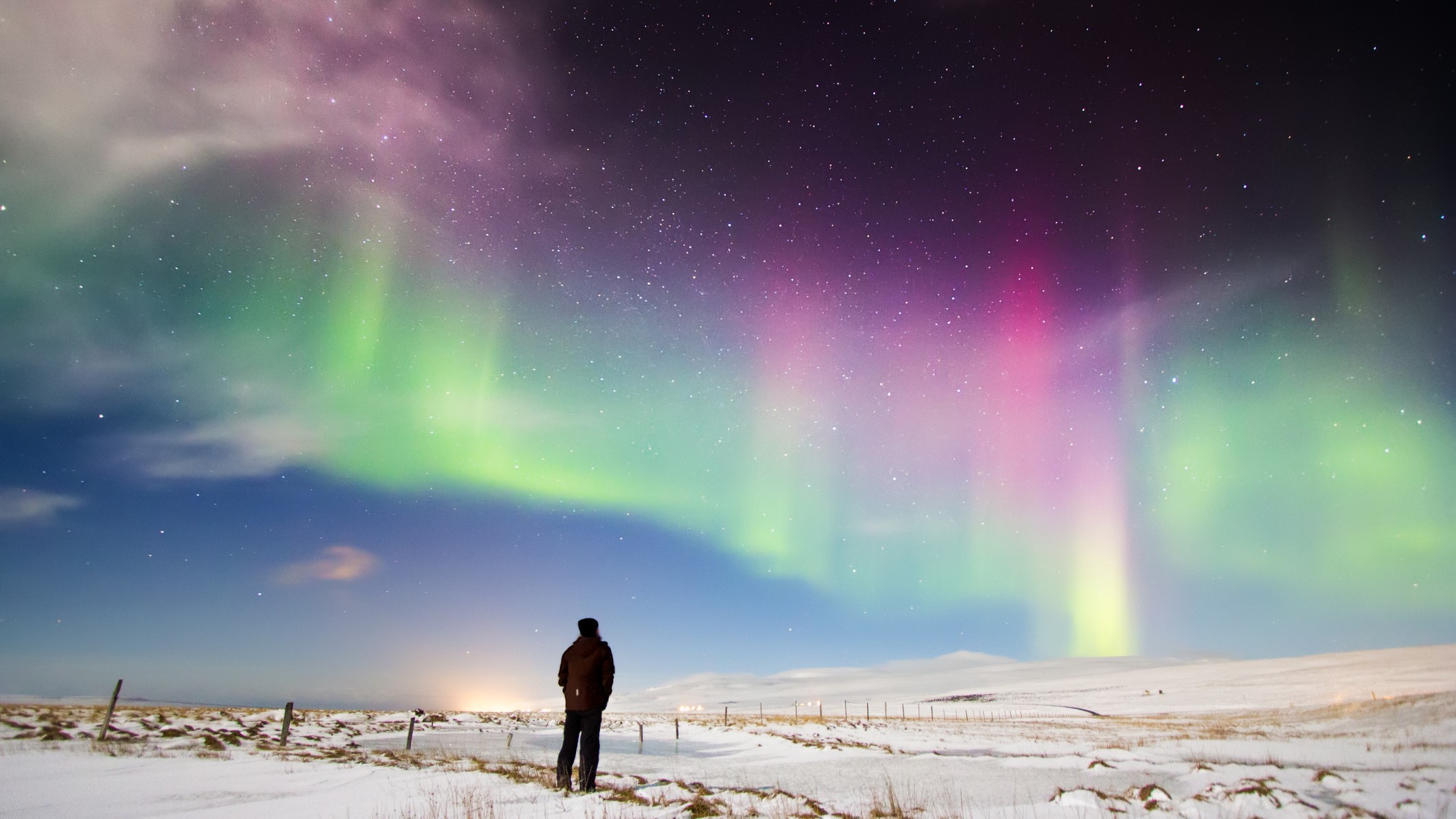
Our aurora forecast live blog tells you everything you need to know about the likelihood of seeing the northern lights tonight and for the days ahead.
We'll also report on relevant solar activity and significant space weather events such as coronal mass ejections (CMEs) and coronal holes which could bring strong aurora-sparking solar winds our way.
REMEMBER: The Kp index is important, with a higher Kp indicating stronger auroral activity. A key ingredient of aurora activity is the Bz value of the Interplanetary Magnetic Field, which can be easily viewed on SpaceWeatherLive.com. You're ideally looking for a strong "south" Bz which means it will connect with Earth's magnetosphere which points northward. A strong southward Bz can wreak havoc with Earth's magnetic field and send particles raining down through the atmosphere along magnetic field lines. When these energized particles collide with atoms in Earth's atmosphere they release the light we see as auroras. If there is a strong southward Bz, your chances of seeing auroras increase significantly.
Best year for auroras | Aurora colors | Aurora myths | Where to see
Monday, Nov. 8: Quiet sun but aurora sightings possible at high latitudes
Today there is a good possibility of seeing the northern lights at high latitudes primarily above the Arctic Circle. A maximum Kp of around 3 Kp is predicted for tonight from around 1:00 - 7:00 p.m. EST (1800-0000 GMT), according to the National Oceanic and Atmospheric Administration (NOAA)'s Space Weather Prediction Center. This could bring unsettled aurora activity in high latitudes.
A large Earth-facing coronal hole could also bring an increase in geomagnetic activity over the coming days. When directed at Earth, the stream of solar wind flowing from a coronal hole can impact Earth's magnetosphere, triggering geomagnetic storm conditions and resulting in impressive aurora displays.
The sun has been rather quiet of late, but if it unleashes a powerful solar flare (either M or X class) accompanied by a coronal mass ejection (CME) in the coming days, we could be in for an aurora treat. CMEs are large plumes of plasma and magnetic field that erupt from the sun. When they collide with Earth they can trigger geomagnetic storms which in turn lead to dramatic auroras.
Current solar flare predictions for today courtesy of SpaceWeatherLive.com
M-class solar flare: 50%
X-class solar flare: 10%
Tuesday, Nov. 19: Low Kp predicted but active sun could spell good conditions for later in the week
Today there is still a good chance of seeing the northern lights at high latitudes primarily above the Arctic Circle, despite lower Kp predictions compared to yesterday. A maximum Kp of around 2 is predicted for tonight from around 4 - 7 p.m. EST (2100-0000 GMT), according to the National Oceanic and Atmospheric Administration (NOAA)'s Space Weather Prediction Center. This could bring unsettled aurora activity in high latitudes.
A large coronal hole continues to face Earth and may trigger increased geomagnetic activity over the coming days. When directed at Earth, the stream of solar wind flowing from a coronal hole can impact Earth's magnetosphere, triggering geomagnetic storm conditions and resulting in impressive aurora displays.
The sun appears to be "waking up" from a brief hiatus in solar activity, unleashing nine M-class solar flares yesterday. A majority of the flares originated from a newly emerging sunspot group AR3901. The sunspot is turning toward Earth which means if it unleashes a powerful solar flare (either M or X class) accompanied by a coronal mass ejection (CME) in the coming days, we could be in for an aurora treat. CMEs are large plumes of plasma and magnetic field that erupt from the sun. When they collide with Earth they can trigger geomagnetic storms which in turn lead to dramatic auroras.
Current solar flare predictions for today courtesy of SpaceWeatherLive.com
M-class solar flare: 55%
X-class solar flare: 10%
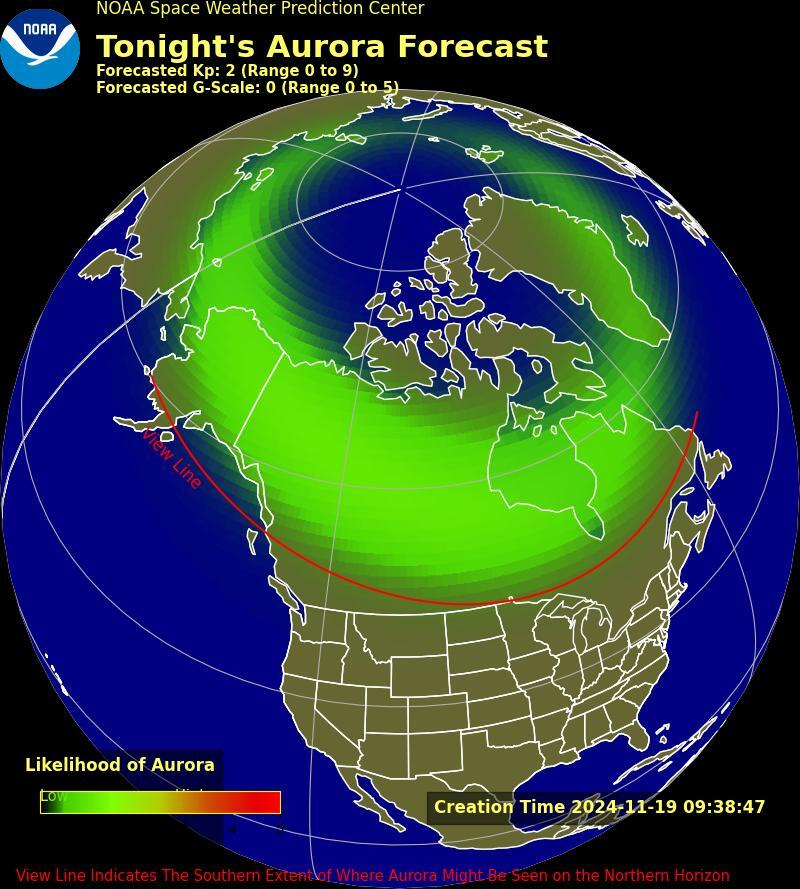
Wednesday Nov. 20: Auroras possible at high latitudes despite relatively quiet sun
Even with low Kp predictions, there’s still a good opportunity to spot the northern lights today at high latitudes, particularly in areas above the Arctic Circle.
A maximum Kp of around 1.7 is currently predicted for tonight from around 7-10 p.m. EST (0000-0300 GMT on Nov.21), according to the NOAA's Space Weather Prediction Center.
Tonight's aurora activity could also be fuelled by a significant coronal hole that remains pointed toward Earth. Solar wind streams from coronal holes can interact with the planet's magnetosphere, potentially causing geomagnetic storms and creating stunning aurora displays. So while the Kp index is low, there is still a possibility of a nice show at high latitudes this evening.
While geomagnetic activity is forecasted to remain relatively low in the coming days, this could quickly change with the eruption of a coronal mass ejection (CME), potentially resulting in striking auroral displays. CMEs are enormous eruptions of plasma and magnetic energy released from the sun, often associated with powerful solar flares. Upon reaching Earth, they can induce geomagnetic storm conditions that give rise to breathtaking auroras. We will be sure to update you if any eruptions give rise to Earth-directed CMEs!
Current solar flare predictions for today courtesy of SpaceWeatherLive.com
M-class solar flare: 50%
X-class solar flare: 10%
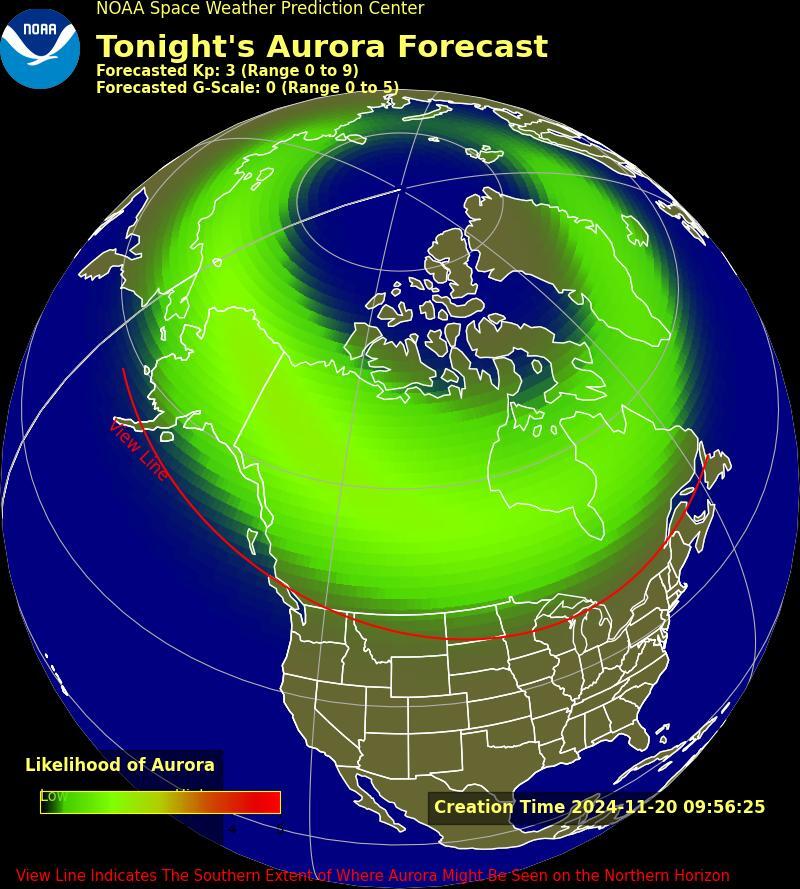
Thursday, Nov. 21: Quiet aurora activity but conditions improving
Despite low Kp predictions, there’s still a possibility to see the northern lights today at high latitudes, particularly in areas above the Arctic Circle.
A maximum Kp of around 2 is currently predicted for tonight from around 7-10 p.m. EST (0000-0300 GMT on Nov.22), according to the NOAA's Space Weather Prediction Center. Kp's of 2 are not uncommon but it is a slight improvement on yesterday's forecast.
We could see a slight bump in aurora activity by the Earth-directed coronal hole that is currently present on the sun. However, it has shrunk significantly in the last few days and will not face Earth for much longer. But we constantly monitor the sun for other significant coronal hole formations. Solar wind streams from coronal holes can interact with the planet's magnetosphere, potentially causing geomagnetic storms and creating stunning aurora displays.
We could see a better aurora forecast tomorrow with maximum Kps of around 3 currently predicted.
While the forecast is still not too promising we need to remember that this can all change very quickly if the sun erupts with a coronal mass ejection (CME). CMEs are powerful eruptions of plasma and magnetic field from the sun, when Earth-directed they can slam into our magnetosphere and trigger geomagnetic storm conditions which in turn can lead to fantastic aurora displays. CMEs often accompany powerful solar flare eruptions (M or X class) so we will be sure to update you if any eruptions give rise to Earth-directed CMEs!
Current solar flare predictions for today courtesy of SpaceWeatherLive.com
M-class solar flare: 50%
X-class solar flare: 10%
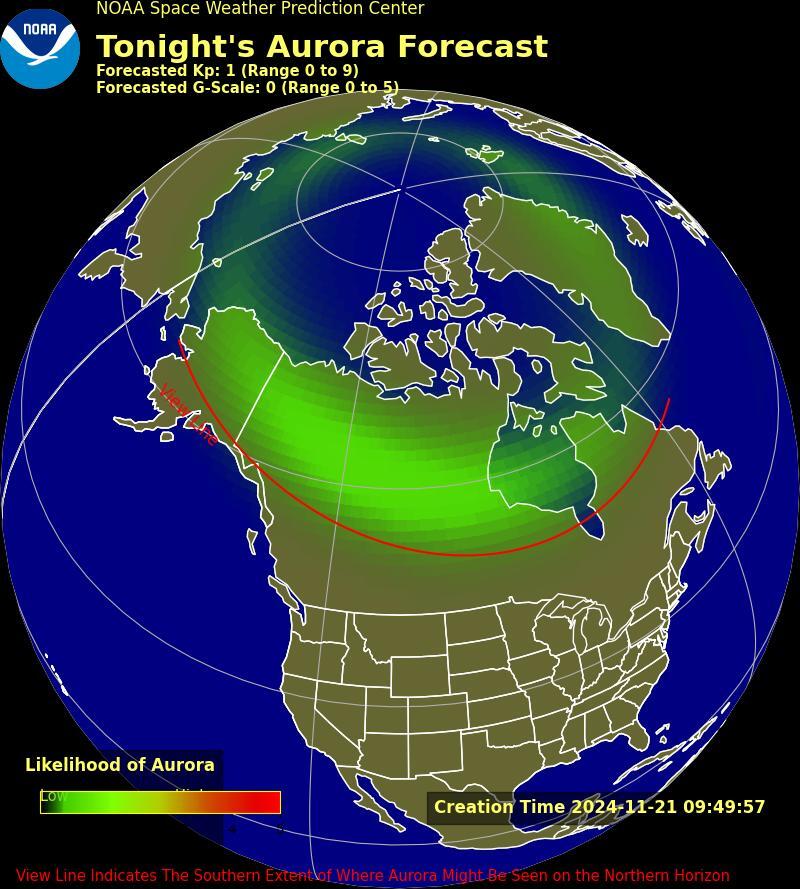
Tonight and the weekend
Quiet aurora and dramatic farside eruption from the sun
The current forecast for tonight and over the weekend suggests it's likely to see the northern lights at high latitudes, particularly in areas above the Arctic Circle.
Over the weekend a maximum Kp of around 3 is currently predicted for Saturday night (Nov. 23) according to the NOAA's Space Weather Prediction Center. To get a thorough breakdown of the latest Kp predictions from Nov. 22. to Nov. 24, visit NOAA's 3-day forecast.
Keep in mind, that the sun is rather fickle and can change in an instant. Just when it seemed a bit too quiet, the sun erupted with a massive farside coronal mass ejection (CME). Unfortunately for aurora enthusiasts, the eruption on Nov. 21 doesn’t appear to have an Earth-directed component.
CMEs are powerful eruptions of plasma and magnetic field from the sun, when Earth-directed they can slam into our magnetosphere and trigger geomagnetic storm conditions which in turn can lead to fantastic aurora displays
While the CME was not Earth-directed, the eruption did cause the most energetic solar radiation storm since at least 2005 according to Space Weather Physicist Tamitha Skov.
"This means it was a BIG eruption. Likely launched from Region 3889 or 3897 on the Sun's farside, this #solarstorm doesn't appear to have any Earth-directed component. We can tell because the coronal wave stays localized near the west limb." Skov wrote in a post on X.
This eruption has caused the most energetic solar #RadiationStorm since the 2005 or possibly the 2003 Halloween events (i.e. very hard spectrum). This means it was a BIG eruption. Likely launched from Region 3889 or 3897 on the Sun's farside, this #solarstorm doesn't appear to… https://t.co/3xnw3VYPlj pic.twitter.com/Q43XgLLQD4November 21, 2024
The recent eruption reminds us that the sun can always throw up surprises. While the current weekend forecast doesn't look overly promising for dramatic auroras that can all change very quickly. We'll keep you updated on any significant developments or incoming CMEs.
Low predicted activity but a new explosive player may be entering the game in coming days
A maximum Kp of around 1.7 is currently predicted for tonight according to the NOAA's Space Weather Prediction Center. Despite low Kp predictions, there’s still a possibility of seeing the northern lights today at high latitudes, particularly in areas above the Arctic Circle.
In recent days, significant solar activity has predominantly occurred on the far side of the sun. On Nov. 21, a massive coronal mass ejection (CME) erupted, triggering the most powerful solar radiation storm recorded since at least 2005. Additionally, earlier this morning at 2:30 a.m. EST (0730 GMT), the sun unleashed an M9.45-class solar flare from a region just beyond the northeast limb. This active region, which nearly produced an X-class flare, is expected to rotate into Earth’s view within the next few days, potentially making any subsequent eruptions Earth-directed.
While the current forecast is not too promising, remember that this can change rapidly if the sun erupts with a coronal mass ejection (CME). CMEs are powerful eruptions of plasma and magnetic field from the sun, when Earth-directed they can slam into our magnetosphere and trigger geomagnetic storm conditions which in turn can lead to fantastic aurora displays. CMEs often accompany powerful solar flare eruptions (M or X class) so we will be sure to update you if any eruptions give rise to Earth-directed CMEs!
Current solar flare predictions for today courtesy of SpaceWeatherLive.com
M-class solar flare: 55%
X-class solar flare: 15%
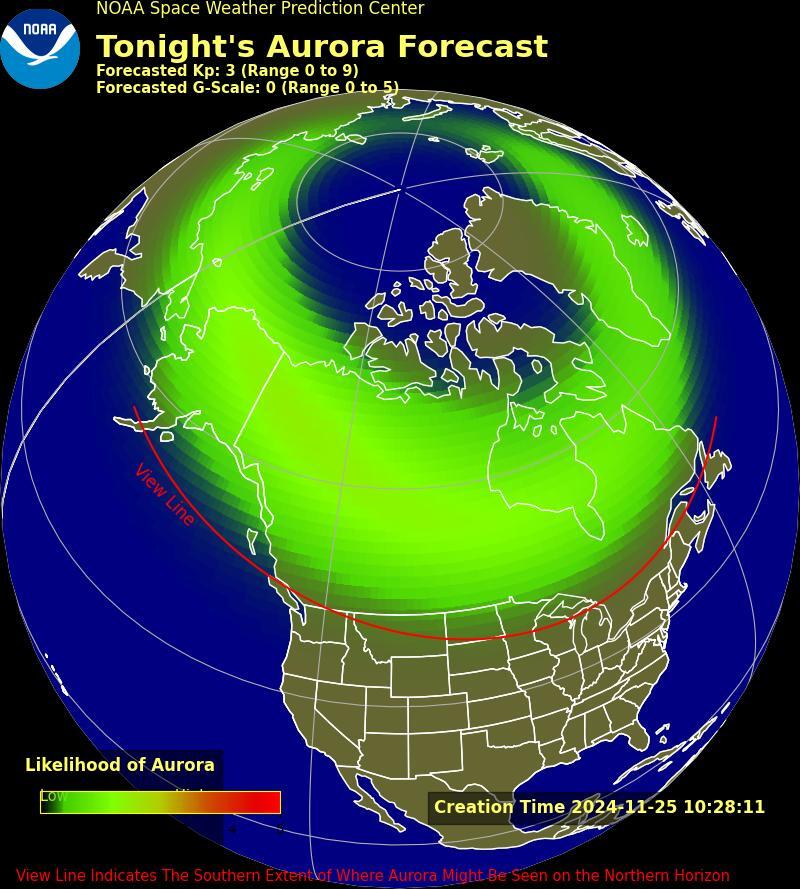
Aurora conditions improving and possible Earth-directed solar storm
Finally, some promising aurora news! A coronal mass ejection (CME) erupted from the sun on Nov. 25 and may deliver a glancing blow to Earth in time for the Thanksgiving holidays.
CMEs are powerful eruptions of plasma and magnetic field from the sun, when Earth-directed they can slam into our magnetosphere and trigger geomagnetic storm conditions which in turn can lead to impressive auroras.
The eruption from sunspot region 3901 could result in a glancing blow impact predicted for around Nov. 28.
"Waiting for coronagraph imagery to confirm, but we might get some #aurora over the Thanksgiving holiday!" Space Weather Physicist Tamitha Skov wrote in a post on X.
Finally, a potentially Earth-directed #solarstorm! After a lot of eye-candy in all directions from our Sun, Region 3901 fires an M-flare and launches a storm towards us! waiting for coronagraph imagery to confirm, but we might get some #aurora over the Thanksgiving holiday! pic.twitter.com/7m2dQXEdRFNovember 25, 2024
And that's not all!
The active sunspot region that released an M9 (almost X)-class solar flare on Nov. 25 is currently turning into view. The region has already proven its explosive capabilities, which may become geoeffective as the region turns to face Earth toward the end of the week. Space weather scientists will be watching this region carefully.
As it stands, a maximum Kp of around 2 is currently predicted for tonight according to the NOAA's Space Weather Prediction Center. Despite low Kp predictions, there’s still a good chance of seeing the northern lights tonight at high latitudes, particularly in areas above the Arctic Circle.
Current solar flare predictions for today courtesy of SpaceWeatherLive.com
M-class solar flare: 55%
X-class solar flare: 15%
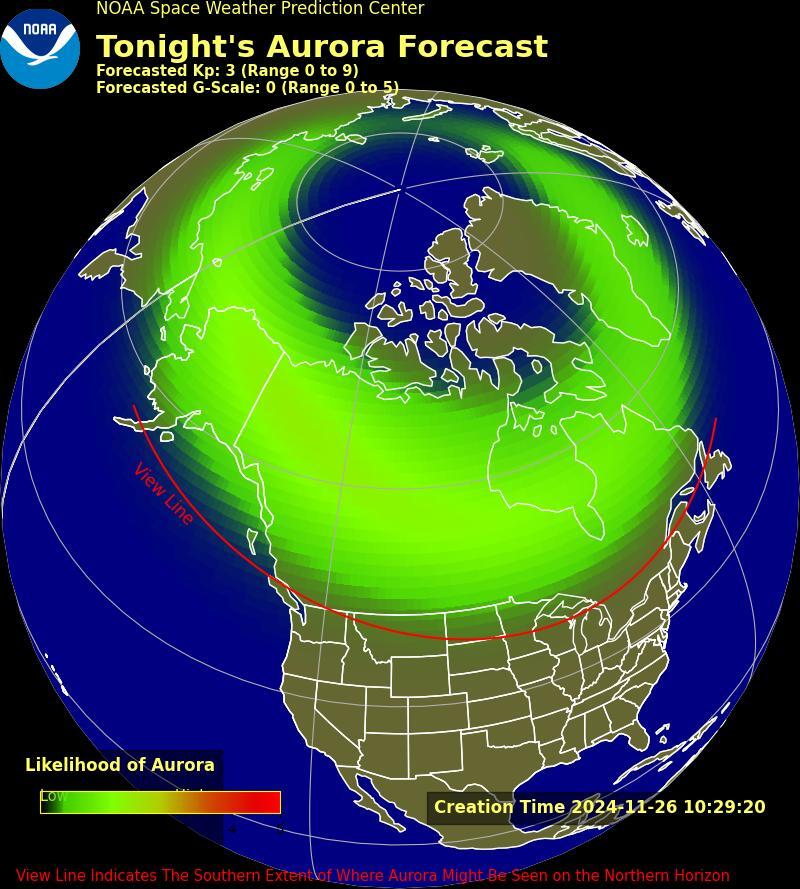
Keep your eyes skyward for possible Thanksgiving aurora!
You might have something to be extra thankful for this Thanksgiving, as the chances of aurora gracing our skies over the holiday are going up! A Nov. 25 coronal mass ejection (CME) from sunspot region 3901 is headed in our direction. The CME has resulted in a G1 (Minor) watch and a G2 (Moderate) watch for Nov. 28 and 29, respectively, according to a post on X from the NOAA Space Weather Prediction Center.
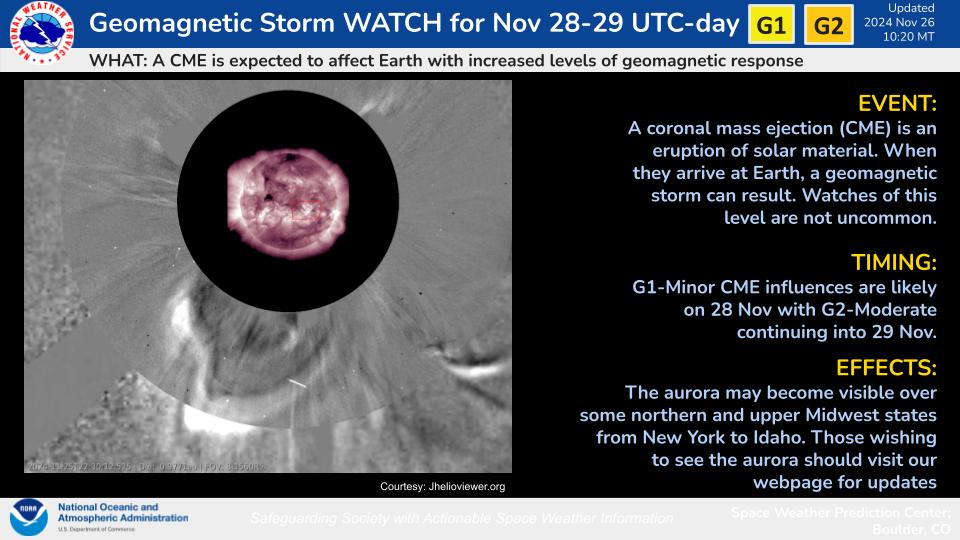
A G1 (Minor) watch has been issued for 28 Nov and a G2 (Moderate) watch was issued for 29 Nov due to the arrival of a CME associated with a filament eruption that took off the Sun late on 25 Nov. pic.twitter.com/pg1yihQdQyNovember 26, 2024
Good chance of auroras tonight and tomorrow
Good news aurora chasers! Things are looking up (and you should be too!)
A maximum Kp of around 3 is currently predicted for tonight according to the NOAA's Space Weather Prediction Center. But tomorrow night this rises close to Kp 6. NOAA has issued a geomagnetic storm watch for Nov. 28 and 29, with possible G1 and G2 conditions expected.
If G2 conditions are reached, the northern lights may be visible as far south as New York and Idaho.
You can keep up to date with the latest Kp breakdown for the next three days on NOAA's SWPC. We will update you on any significant developments here too.
We could be in for a nice aurora show over Thanksgiving as the thin waxing moon is nearing the new moon phase on Dec. 1, so moonlight will not interfere with northern lights viewing efforts. We are also in the midst of the Geminid meteor shower so when while you're out hunting auroras be sure to keep an eye out for some impressive Geminid meteors.
Current solar flare predictions for today courtesy of SpaceWeatherLive.com
M-class solar flare: 65%
X-class solar flare: 20%
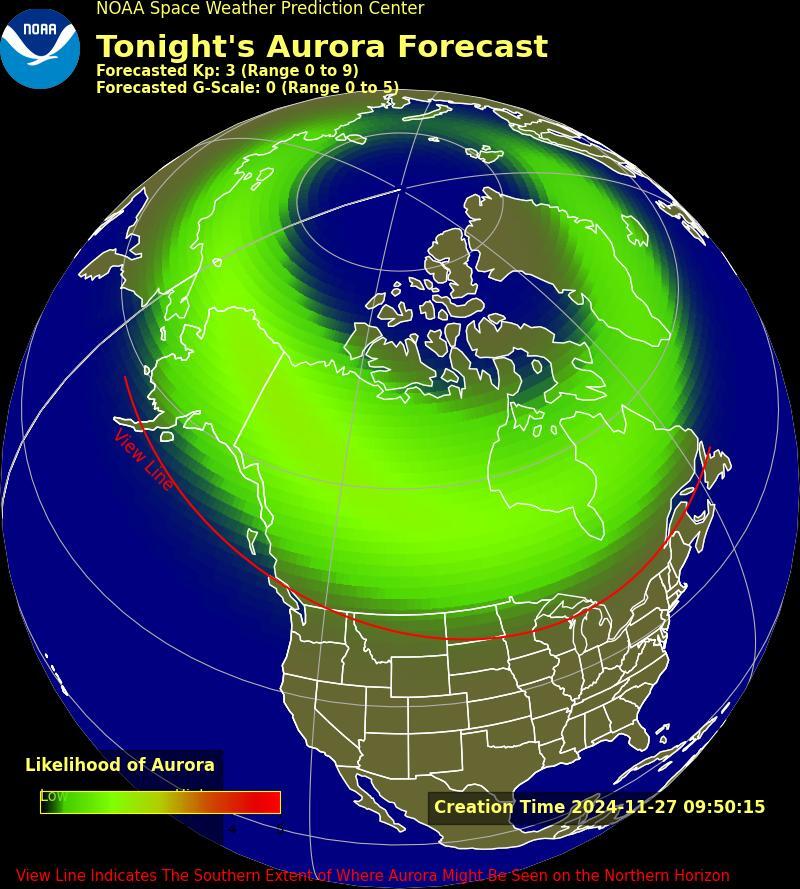
Aurora alert: Thanksgiving northern lights could delight tonight

Tonight, there is a good chance of seeing the northern lights at high latitudes.
A maximum Kp of around 6 is currently predicted for tonight according to the NOAA's Space Weather Prediction Center.
NOAA's G1-G2 geomagnetic storm watch for Nov. 28 and Nov. 29 remains in place. If G2 conditions are reached, the northern lights may be visible as far south as New York and Idaho.
You can keep up to date with the latest Kp breakdown for the next three days on NOAA's SWPC. We will update you on any significant developments here too.
Visibility tonight will be good, as the thin waxing crescent moon is only 7% illuminated, providing dark skies for optimum northern lights viewing. Also, keep your eye out for the Geminid meteor shower, which is currently active.
There are a few active large sunspot regions on the sun today giving a high chance of some explosive eruptions.
Current solar flare predictions for today courtesy of SpaceWeatherLive.com
M-class solar flare: 65%
X-class solar flare: 20%
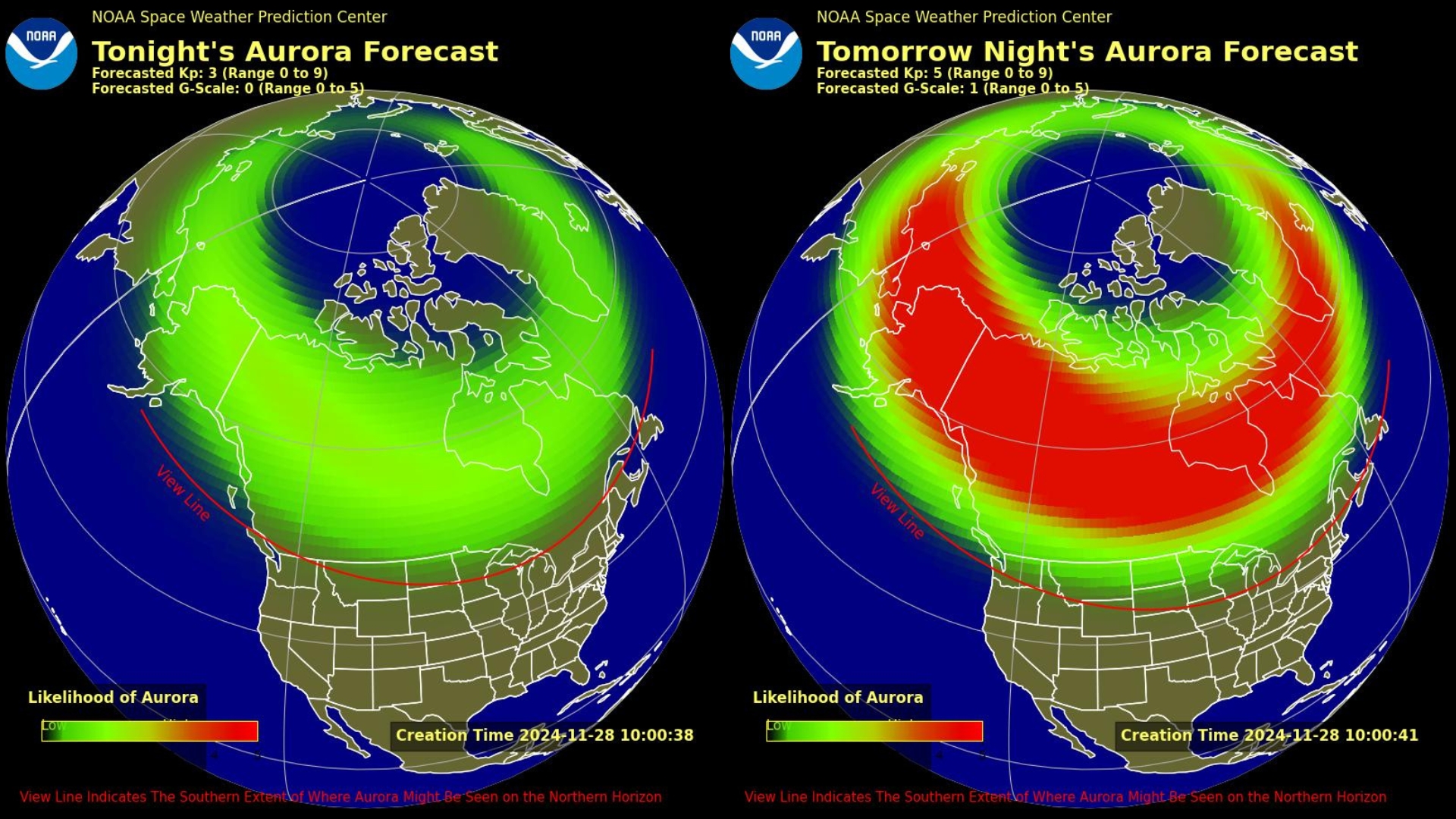
Northern lights forecast for tonight and the weekend
The aurora forecast for tonight and the weekend remains relatively positive, especially for those in high latitudes.
A maximum Kp of around 3 is currently predicted for tonight according to the NOAA's Space Weather Prediction Center.
Aurora chasers had been eagerly awaiting the arrival of a CME that left the sun on Nov. 25. Unfortunately, they were left in the dark as the CME struck Earth's magnetic field on Nov. 28 around 9:45 p.m. EST (0245 GMT on Nov. 29) but failed to spark the anticipated geomagnetic storm conditions.
According to Space Weather Physicist Tamitha Skov's recent space weather forecast on YouTube, solar weather could pick up this week as more active regions rotate into view, increasing our chances of solar storms. A good window of aurora viewing opportunities, especially at high latitudes remains over the holiday weekend.
Monday Dec. 2: Good possibility of northern lights at high latitudes
There is a good chance of seeing auroras at high latitudes tonight, with a maximum predicted Kp of 3 indicated by NOAA's Space Weather Prediction Center. The 1% illuminated new moon tonight will also provide dark skies perfect for aurora hunting and skywatching.
According to the astronomy website SpaceWeatherLive the aurora probability forecast for tonight is:
We could see a slight bump in aurora activity over the next few days as a large coronal hole turns to face Earth.
The coronal hole is visible in GOES-16 satellite imagery. We currently do not have any Solar Dynamics Observatory (SDO) imagery or data due to a flood at Standford University's Joint Center for Science Operations damaging the servers.
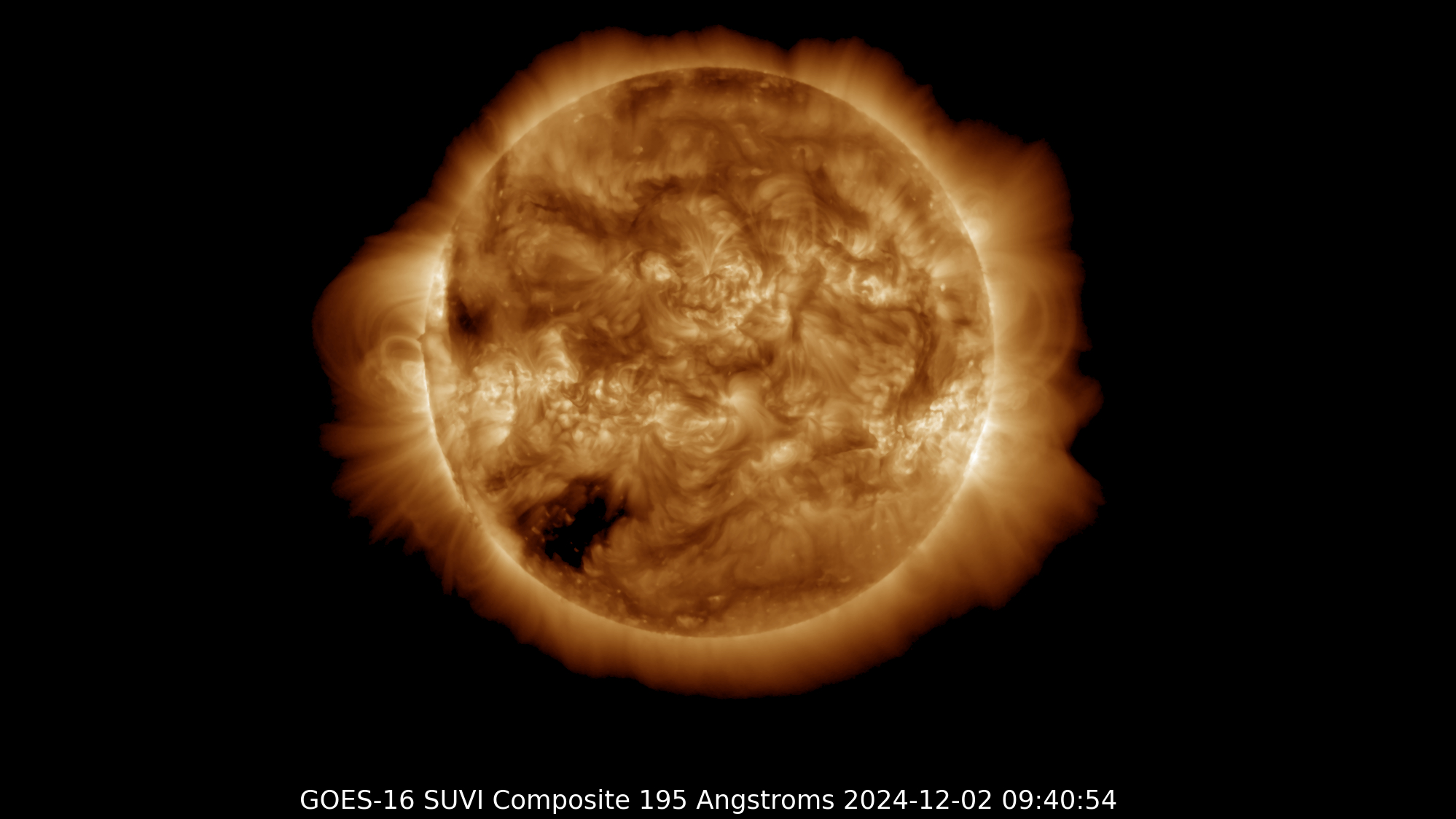
Solar wind streams from coronal holes can interact with the planet's magnetosphere, potentially causing geomagnetic storms and creating stunning aurora displays.
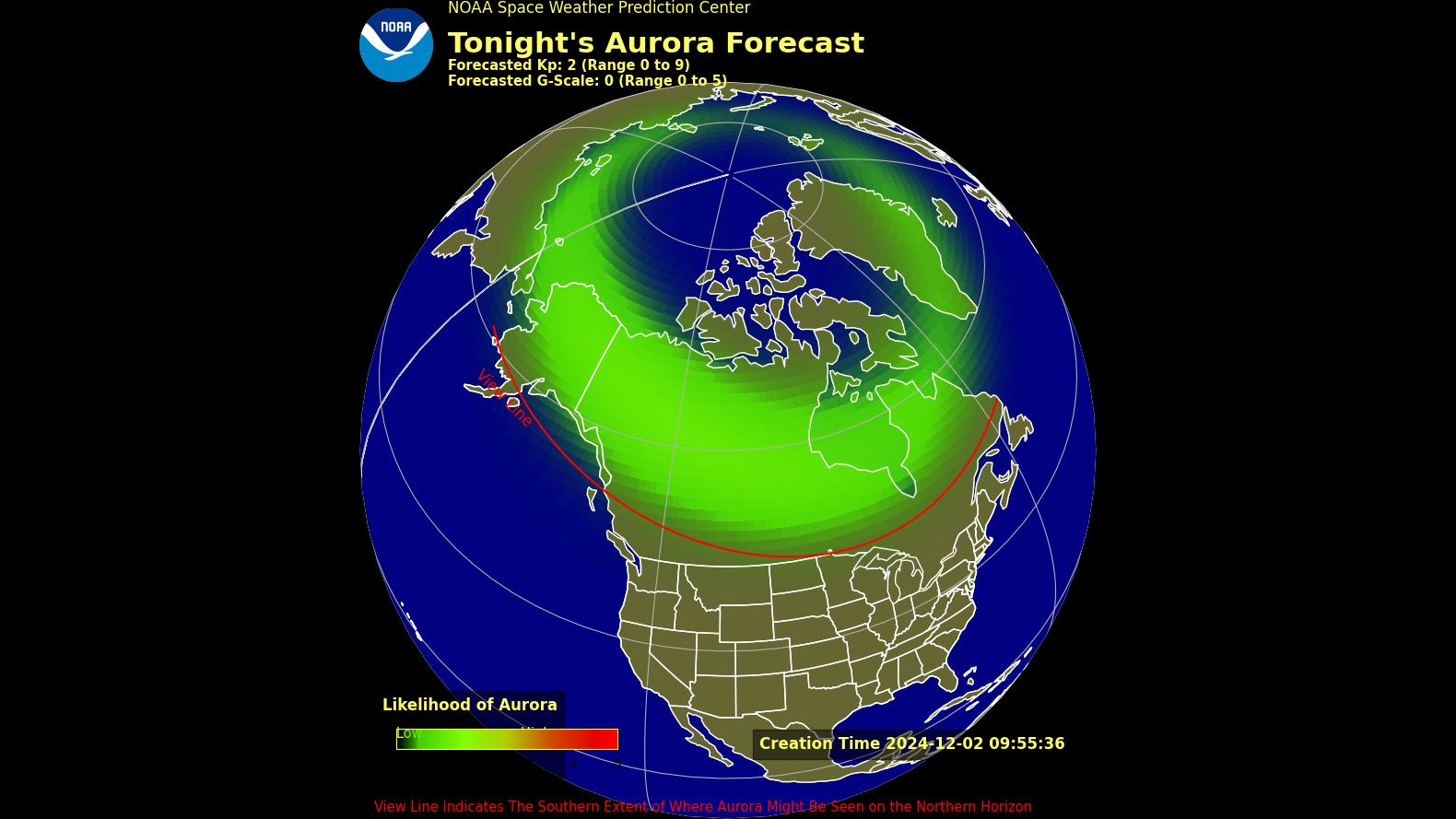
Tuesday, Dec. 3: Fair chance of northern lights at high latitudes
There is a fair chance of seeing auroras at high latitudes tonight, with a maximum predicted Kp of around 2.7, as indicated by NOAA's Space Weather Prediction Center. The 4% illuminated waxing crescent moon tonight will also provide dark skies perfect for aurora hunting and skywatching.
According to the astronomy website SpaceWeatherLive the aurora probability forecast for tonight is:
Over the next few days, we may observe a rise in aurora activity as a large coronal hole turns to face Earth.
The coronal hole is visible as a large dark patch in GOES-16 satellite imagery. We currently do not have any Solar Dynamics Observatory (SDO) imagery or data due to a flood at Standford University's Joint Center for Science Operations damaging the servers.
Read more: Broken water pipe knocks out data processing for NASA sun-studying spacecraft
Wednesday, Dec. 4: Large coronal holes could spark auroras in coming days
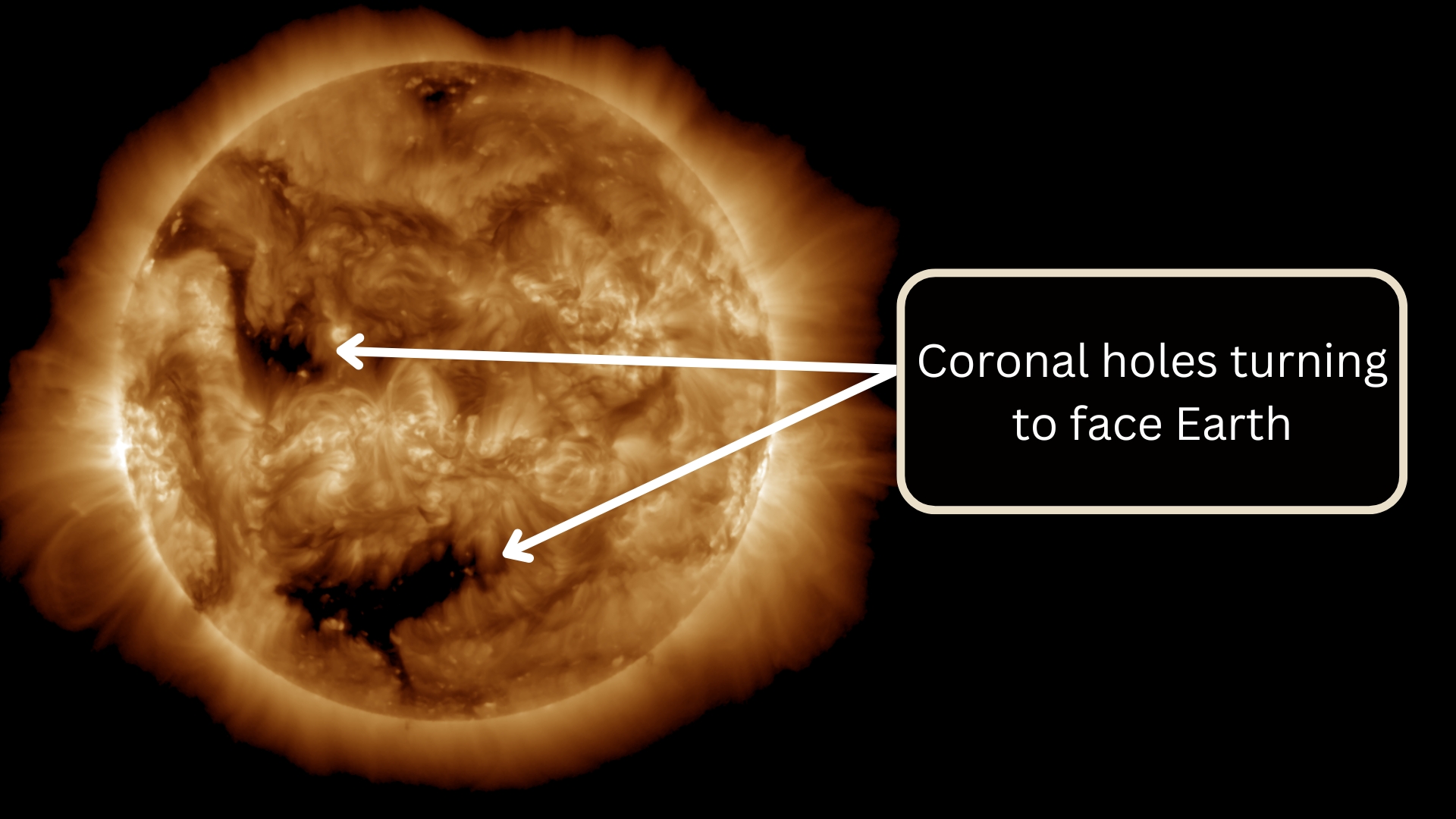
If you're hoping to catch a glimpse of the northern lights tonight, there's a decent chance for those at higher latitudes. According to NOAA's Space Weather Prediction Center, the aurora forecast predicts a maximum Kp index of approximately 1.7. While this is on the lower end of activity, it’s still worth keeping an eye on the skies, especially in areas with minimal light pollution.
Adding to the favorable conditions, tonight’s waxing crescent moon is just 10% illuminated. This means darker skies, offering an ideal backdrop for aurora-hunting and skywatching enthusiasts.
Over the next few days, we may observe a rise in aurora activity as two large coronal holes turn to face Earth. This is good news for aurora chasers as coronal holes release high-speed solar wind streams. When these particles interact with Earth's magnetic field they increase geomagnetic activity which in turn can spark intense auroras. We could see a rise in aurora activity by the weekend.
The coronal holes are visible as large dark patches in GOES-16 satellite imagery.
Thursday, Dec. 5: Fair chance of auroras at high latitudes, conditions improving
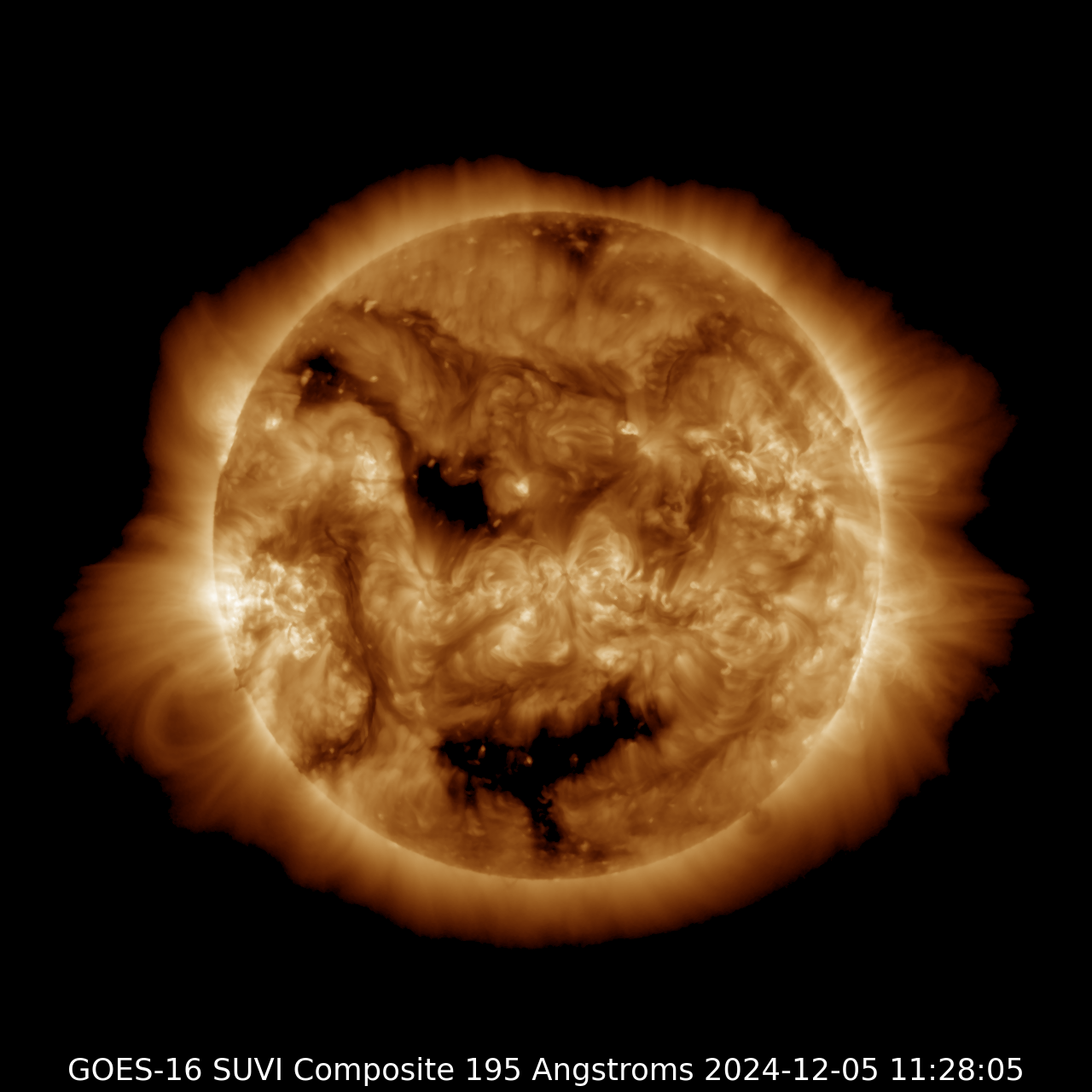
Today there is a good possibility of seeing the northern lights at high latitudes primarily above the Arctic Circle. A maximum Kp of around 1.7 is predicted for tonight from around 1:00 - 10:00 p.m. EST (1800-0300 GMT), according to the National Oceanic and Atmospheric Administration (NOAA)'s Space Weather Prediction Center.
A large Earth-facing coronal hole could also bring an increase in geomagnetic activity over Dec. 6 and Dec. 7. When directed at Earth, the stream of solar wind flowing from a coronal hole can impact Earth's magnetosphere, triggering geomagnetic storm conditions and resulting in impressive aurora displays.
The sun has been rather quiet of late, but if it unleashes a powerful solar flare (either M or X class) accompanied by a coronal mass ejection (CME) in the coming days, we could be in for an aurora treat. CMEs are large plumes of plasma and magnetic field that erupt from the sun. When they collide with Earth they can trigger geomagnetic storms which in turn lead to dramatic auroras.
Current solar flare predictions for today courtesy of SpaceWeatherLive.com
M-class solar flare: 30%
X-class solar flare: 5%
Northern lights forecast for tonight and the weekend
There is a good chance of auroras at high latitudes over the weekend, with a maximum predicted Kp of 3 according to NOAA's Space Weather Prediction Center.
While geomagnetic activity is forecasted to remain relatively low in the coming days, this could quickly change with the eruption of a coronal mass ejection (CME), potentially resulting in striking auroral displays. CMEs are enormous eruptions of plasma and magnetic energy released from the sun, often associated with powerful solar flares. Upon reaching Earth, they can induce geomagnetic storm conditions that give rise to breathtaking auroras. We will be sure to update you if any eruptions give rise to Earth-directed CMEs!
Monday, Dec. 9: Sporadic auroras likely this week
Expect good northern lights at high latitudes with possible heightened activity by Dec. 11.
A large coronal hole is currently facing Earth and continues to feed Earth's magnetosphere with a stream of fast-flowing solar wind triggering active aurora conditions, as reported by space weather and aurora website SolarHam in a post on X.
Coronal hole #98 is now facing Earth. A solar wind stream flowing from this zone appears to be moving past Earth. Unsettled (Kp3) to Active (Kp4) conditions will be possible should the Bz component of the IMF point south for any prolonged period of time. https://t.co/aqK4Q6XdAY pic.twitter.com/1da8my9qNBDecember 9, 2024
Yesterday (Dec. 8) the sun fired off an X-class solar flare accompanied by a coronal mass ejection (CME).
"The #solarstorm launched will graze Earth to the west. Sadly, the coming fast solar wind streams might deflect the structure even further to the west. Expect only mild impacts by midday December 11," Space Weather Physicist Tamitha Skov wrote in a post on X.
According to NOAA's Space Weather Prediction Center, the highest predicted Kp index for the next 24 hours is 2.67.
Skov took to X to post a 5-day space weather outlook, noting sporadic auroras likely at high latitudes due to fast solar wind and possible glancing blow from the CME on Wednesday.
The latest 5-Day Outlooks: Expect sporadic #Aurora at high latitudes due to a fast solar wind stream hitting now & a glancing #SolarStorm blow by Wednesday. Risks for R3-level #RadioBlackouts & #RadiationStorms remain elevated over the next 48 hours but should calm by mid-week. pic.twitter.com/dV9dUoifSbDecember 9, 2024
Tuesday Dec. 10: Great chance of auroras for those at high latitudes tonight
There is a great chance of auroras at high latitudes tonight. According to NOAA's Space Weather Prediction Center, the highest predicted Kp index for the next 24 hours is 3.67.
The large coronal hole continues to face us and feed Earth's magnetosphere with a stream of fast-flowing solar wind, which can trigger active geomagnetic conditions and impressive auroras.
Wednesday Dec. 11: Very good chance of auroras at high latitudes tonight
There is a very good chance of auroras at high latitudes tonight. According to NOAA's Space Weather Prediction Center, the highest predicted Kp index for the next 24 hours is 3.
Though a large coronal hole continues to face us and feed Earth's magnetosphere with a stream solar wind, these solar wind speeds have eased slightly in the last 24 hours according to the UK's national weather and climate service the Met Office.
We could experience unsettled geomagnetic activity by Dec. 13 due to a connection to the fast winds from another coronal hole, according to the Met Office. These could lead to sporadic active intervals of higher geomagnetic activity, so keep your eyes on the skies. You never know, you may catch a glimpse of the occasional Geminid meteor too!
Thursday Dec. 12: Fair chance of auroras at high latitudes, enhanced solar wind possible
There is a fair chance of auroras at high latitudes tonight. According to NOAA's Space Weather Prediction Center, the highest predicted Kp index for the next 24 hours is 1.67.
Enhanced solar wind could be observed on Dec. 14 through Dec. 15 due to a fast solar wind emitted from an Earth-facing coronal hole according to UK's national weather and climate service the Met Office.
A large coronal mass ejection (CME)—a vast plume of plasma and magnetic field—was released from the sun yesterday (Dec. 11). However, it emanated from the backside of the sun and so has no Earth-directed component.
Now that SOHO has backfilled the images from the far side CME we can see that it was a full halo. https://t.co/M5pb1Orh3d pic.twitter.com/J6QzAuvOsZDecember 12, 2024
Northern lights forecast for tonight and the weekend
There is a good chance of auroras at high latitudes tonight and over the weekend. According to NOAA's Space Weather Prediction Center, the highest anticipated Kp index for the next three days is 2.67, currently predicted for Dec. 15.
The rise in Kp by Dec. 14 and Dec. 15 is likely due to the fast solar wind emitted from an Earth-facing coronal hole according to the UK's national weather and climate service the Met Office.
Two M-class solar flares, the second most powerful category of solar flares, erupted from the sun on Dec. 12. It remains unclear whether these events were accompanied by notable coronal mass ejections (CMEs) with Earth-directed components.
Double boom! M2.2 and M1.6 flares from active region 3922 this afternoon. Both events appear to have been eruptive, awaiting coronagraph imagery to ascertain if there are noteworthy CMEs. Active region 3922 is rotating into an increasingly Earth-facing position. pic.twitter.com/Zda0OBWmnwDecember 12, 2024
The active region responsible for these eruptions, Region 3922, is beginning to rotate into a position facing Earth. Should this region produce significant CMEs in the days ahead, it could be excellent news for aurora enthusiasts.
Northern hemisphere aurora forecast courtesy of Met Office
Monday, Dec. 16: Great chance of northern lights tonight and the days ahead
There is a great chance of auroras at high latitudes tonight.
According to NOAA's Space Weather Prediction Center, the highest anticipated Kp index for the next 24 hours is 4.33.
Space weather activity has increased to moderate levels in recent days and more activity could be on the horizon!
A solar filament lifted off the sun yesterday and a coronal mass ejection (CME) appeared to accompany the event according to the UK's national weather and climate service the Met Office. There appears to be an Earth-directed component of the CME, which is great news for auroras chasers!
Northern hemisphere aurora forecast courtesy of the Met Office
The aurora forecast for the next few days is looking promising. According to the Met Office, at least one, perhaps two CMEs could have Earth-directed components that may arrive between Dec. 17 and Dec. 18.
Space Weather Physicist Tamitha Skov took to X to explain the possibility of an Earth-directed solar storm in the coming days.
"We have lift off! A snake-like filament is launching while passing through the Earth-strike zone!" Skov wrote in a post on X. "This means we likely have an Earth-directed #solarstorm, finally. Impact possible by midday December 18. Waiting for coronagraph imagery for a better estimate for prediction models," Skov continued.
We have lift off! A snake-like filament is launching while passing through the Earth-strike zone! This means we likely have an Earth-directed #solarstorm, finally. Impact possible by midday December 18. Waiting for coronagraph imagery for a better estimate for prediction models. pic.twitter.com/0E2XMujNYFDecember 15, 2024
Tuesday Dec. 17: Geomagnetic storm warning issued, more auroras could be on the way
Solar activity is improving for aurora chasers with favorable northern lights conditions predicted for tonight for those at high latitudes.
A coronal mass ejection — a plume of plasma and magnetic field from the sun — unexpectedly impacted Earth this morning at 12:19 a.m. EST (Dec. 17) at 0519 GMT. The CME was only predicted to narrowly miss Earth, but instead, it delivered a direct hit, triggering G1 geomagnetic storm conditions. Strong auroras were visible in the northern U.S. and Canada.
Yellowknife cam right now 😍 even with that moon #aurora pic.twitter.com/xbRzSAhQxADecember 17, 2024
Geomagnetic storms occur when solar wind or CMEs from the sun interact with Earth's magnetic field, causing charged particles to enter the atmosphere. These particles collide with gases like oxygen and nitrogen, exciting them and creating the colorful lights we see as auroras, especially near the poles.
According to NOAA's Space Weather Prediction Center, the highest anticipated Kp index for the next 24 hours is 4.33.
Northern Hemisphere aurora forecast courtesy of the Met Office
Wednesday Dec. 18: Good chance of auroras again tonight
Solar wind speeds remain relatively elevated due to the impact of the coronal mass ejection (CME) on Dec. 17. There is a good chance of northern lights at high latitudes.
According to NOAA's Space Weather Prediction Center, the highest anticipated Kp index for the next 24 hours is 3.
The sun unleashed several large CMEs — expulsions of plasma and magnetic field — yesterday (Dec. 17). Though every eruption is predicted to miss Earth, we cannot completely rule out a possible glancing blow. After all the CME that struck on Dec. 17 was forecast to be a glancing blow and ended up being a direct hit.
"There is some uncertainty in the forecast currently," says the U.K.'s national weather and climate service the Met Office.
Northern Hemisphere aurora forecast courtesy of the Met Office
Thursday, Dec. 19: Solar activity slows for now but some big players are on the horizon
There is still a good chance of northern lights at high latitudes. According to NOAA's Space Weather Prediction Center, the highest anticipated Kp index for the next 24 hours is 2.
Aurora watchers at mid-latitudes may feel it's been a while since a major geomagnetic storm lit up the skies. However, that could soon change. Several highly active sunspot regions will be rotating into view in the coming days, raising the potential for dramatic auroral displays.
On Dec. 17, the sun unleashed an extraordinarily fast coronal mass ejection (CME), traveling at an incredible speed of 1,964 miles per second (3,161 km/s). Had it been Earth-directed, it could have reached our planet in under 18 hours.
Read more: Watch the sun unleash 'extremely rare' solar storm in explosive eruption (video)
According to solar astrophysicist Ryan French, the CME had the potential to trigger one of the largest geomagnetic storms of the past few decades!
Yesterday, a *significant* coronal mass ejection erupted from the back of the Sun, with an estimated speed over 3000 km/s. If Earth-directed (and correctly-orientated) this would have had potential to cause one of the largest geomagnetic storms of the past few decades! Fun! (1/4) pic.twitter.com/DrodH1UlsXDecember 18, 2024
We just have to be patient and see what the sun has in store for us when these active regions begin to face Earth. Could some Christmas auroras be on the cards? Only time will tell.
Northern lights forecast for the weekend
There is a fair chance of northern lights at high latitudes. According to NOAA's Space Weather Prediction Center, the highest anticipated Kp index for Dec. 20 to Dec. 22 is 1.67.
It would be a very different story if we were on the other side of the sun. There are some incredibly active regions on the farside of the sun unleashing a barrage of powerful coronal mass ejections (CMEs). Had this happened on the Earth-facing side of the sun, we would have been in for a series of mighty solar storms.
The barrage of three big & fast far side full halo CMEs on Dec 15-19th is quite remarkable. Had this happened on the Earth facing side we would have been in for a series of geomagnetic storms quite possibly rivaling or exceeding the 2003 Halloween storms. Alas ... pic.twitter.com/fpqSBiHr62December 20, 2024
A cluster of sunspots located in the southeast quadrant are beginning to rotate into view and are already crackling with activity.
M3.5 solar flare detected around a cluster of sunspots located in the southeast quadrant at 15:34 UTC (Dec 19). https://t.co/aqK4Q6XLqw pic.twitter.com/Ac4YtZ9RsJDecember 19, 2024
Could some Christmas auroras be on the cards? We'll have to wait and see what the sun has in store for us.
Monday, Dec. 23: Very good chance of auroras tonight at high latitudes
There is a very good chance of northern lights at high latitudes. According to NOAA's Space Weather Prediction Center, the highest anticipated Kp index for Dec. 23 to Dec. 24 is 3.
Aurora chasers at high latitudes could be in for a Christmas treat. On Dec. 24, Earth could receive a glancing blow from a minor coronal mass ejection (CME) that left the sun on Dec. 21. CMEs are vast plumes of plasma and magnetic field from the sun. If they strike Earth and the conditions are right, they can trigger geomagnetic storms, which in turn lead to spectacular aurora displays.
Tuesday, Dec. 24: Enhanced aurora conditions good news for northern observers
The northern lights forecast looks promising in the coming days, driven by the influence of fast solar winds and the potential glancing blow of an incoming coronal mass ejection (CME). CMEs are massive eruptions of plasma and magnetic field from the sun, when they interact with Earth's magnetic field, they can trigger geomagnetic storms. These storms can result in striking auroral displays, sometimes visible as far as the mid-latitudes.
According to NOAA's Space Weather Prediction Center, the highest anticipated Kp index for Dec. 24 to Dec. 25 is Kp 5.33.
NOAA has issued a G1 geomagnetic storm warning for Dec. 25 due to the anticipated arrival of the incoming CME. Elevated geomagnetic conditions could enhance auroras at high latitudes, such as northern Michigan and Maine.
Northern Hemisphere aurora forecast courtesy of the Met Office
Wednesday, Dec. 25: Christmas geomagnetic storm watch!
The sun may be giving some skywatchers a gift this Christmas with a hightened northern lights watch for stargazers across the northernmost U.S. states, as well as north upper Midwest states. A class G1 geomagnetic storm watch is still in effect due to the arrival of solar winds from a coronal mass ejection (CME) that erupted from the sun on Dec. 23. As we said yesterday, such storms can spawn amazing auroral displays, sometimes visible as far as the mid-latitudes.
According to NOAA's Space Weather Prediction Center, the Kp index for Dec. 24 to Dec. 25 reached Kp 4.
NOAA issued a G1 geomagnetic storm warning for Dec. 25 on Monday, Dec. 23 after the CME erupted during a "moderate" M8.9 solar flare from a sunspot region called AR 3932.
Northern Hemisphere aurora forecast courtesy of the Met Office
Thursday, Dec. 26: Boxing Day auroras possible
The chance of auroras for Christmas appears to have fizzled as a potential G1 geomagnetic storm from a solar flare and coronal mass ejection earlier this week did not materialize. However, there is still a chance that the CME may be late, with chances for northern lights over the northern U.K.
"A Coronal Mass Ejection is likely to glance Earth on Wednesday night into Thursday (Christmas Day into Boxing Day), potentially giving aurora over Scotland, with a chance that aurora could extend more widely across Northern Ireland and Northern England and similar geomagnetic latitudes," the U.K. Meteorology Office reported today. "Aurora is likely to be declining by Thursday night, but with a slight chance of reaching northern Scotland."
Northern Hemisphere aurora forecast courtesy of the Met Office
Friday, Dec. 27 and the Weekend: Christmas solar flare
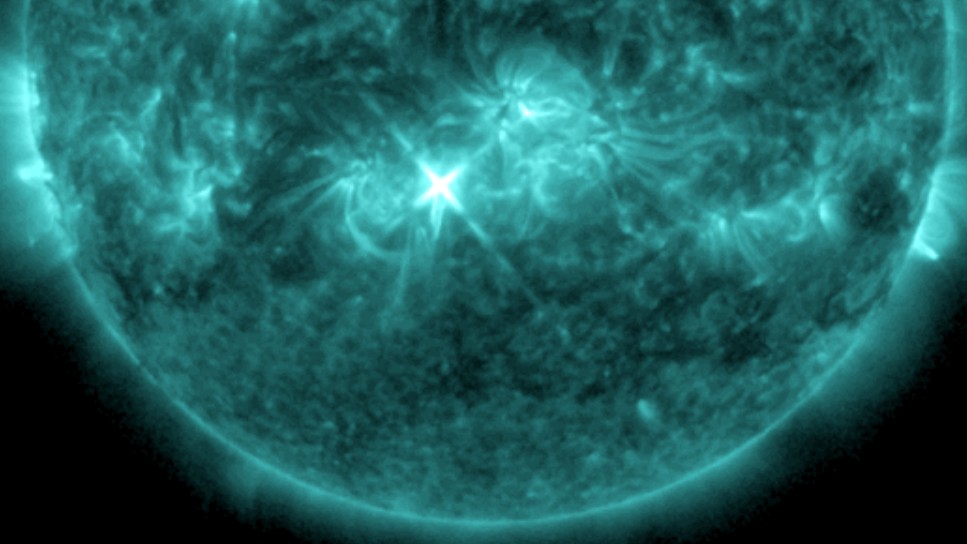
The sun fired off a series of intense solar flares on Christmas Day, Dec. 25, and some of them may amplify the changes of enhanced auroars over the weekend and days leading into New Year's Eve and New Year's Day.
According the U.K. Meteorology Office's space weather center, solar activity is fairly low, with up to 14 sunspot regions on the Earth-facing side of the sun.
"The current southern hemisphere far side [of the sun] is proving a fertile breeding ground for Coronal Mass Ejections (CMEs), with a good many observed through the Christmas period heading south and later southeast from the far side, implying the presence of a large and active region here - potentially of note into the New Year period," MET officials wrote in an update.
Northern Hemisphere aurora forecast courtesy of the Met Office
Monday, Dec. 30: Powerful geomagnetic storm could spark auroras deep into mid-latitudes tonight and tomorrow
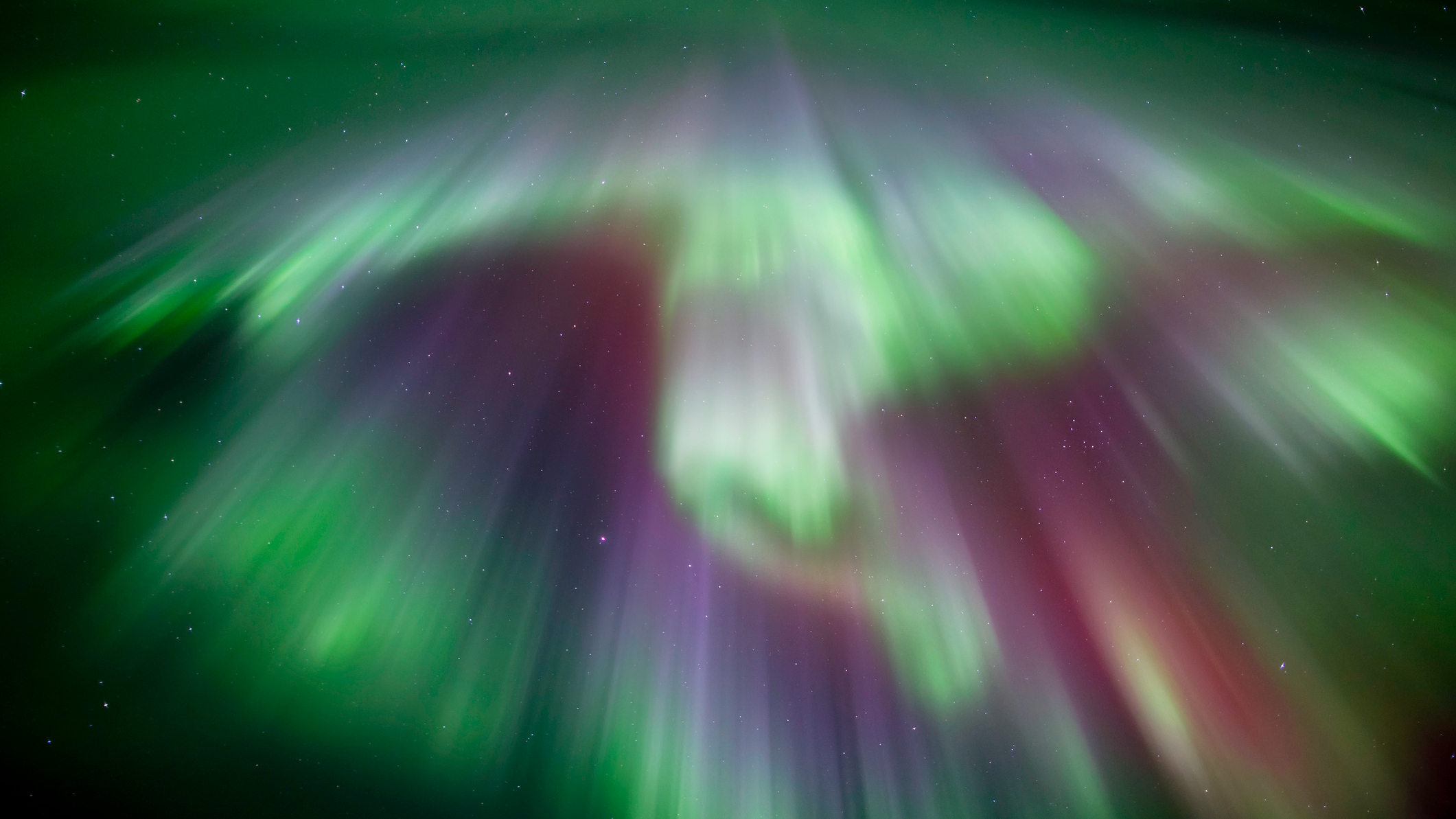
Aurora alert!
We could be in for a New Year's aurora treat with northern lights potentially visible deep into mid-latitudes tonight and tomorrow (Dec. 30 to Dec. 31).
Due to an incoming solar storm, also known as a coronal mass ejection (CME), the National Oceanic and Atmospheric Administration (NOAA) Space Weather Prediction Center issued a G3 (strong) geomagnetic storm warning for Dec. 31.
This is great news for those wishing to see the northern lights as the predicted geomagnetic storm could spark auroras as far south as Illinois and Oregon (around 50° latitude).
Tues.-Wed., Dec. 31-Jan. 1: Coronal mass ejection reaches Earth
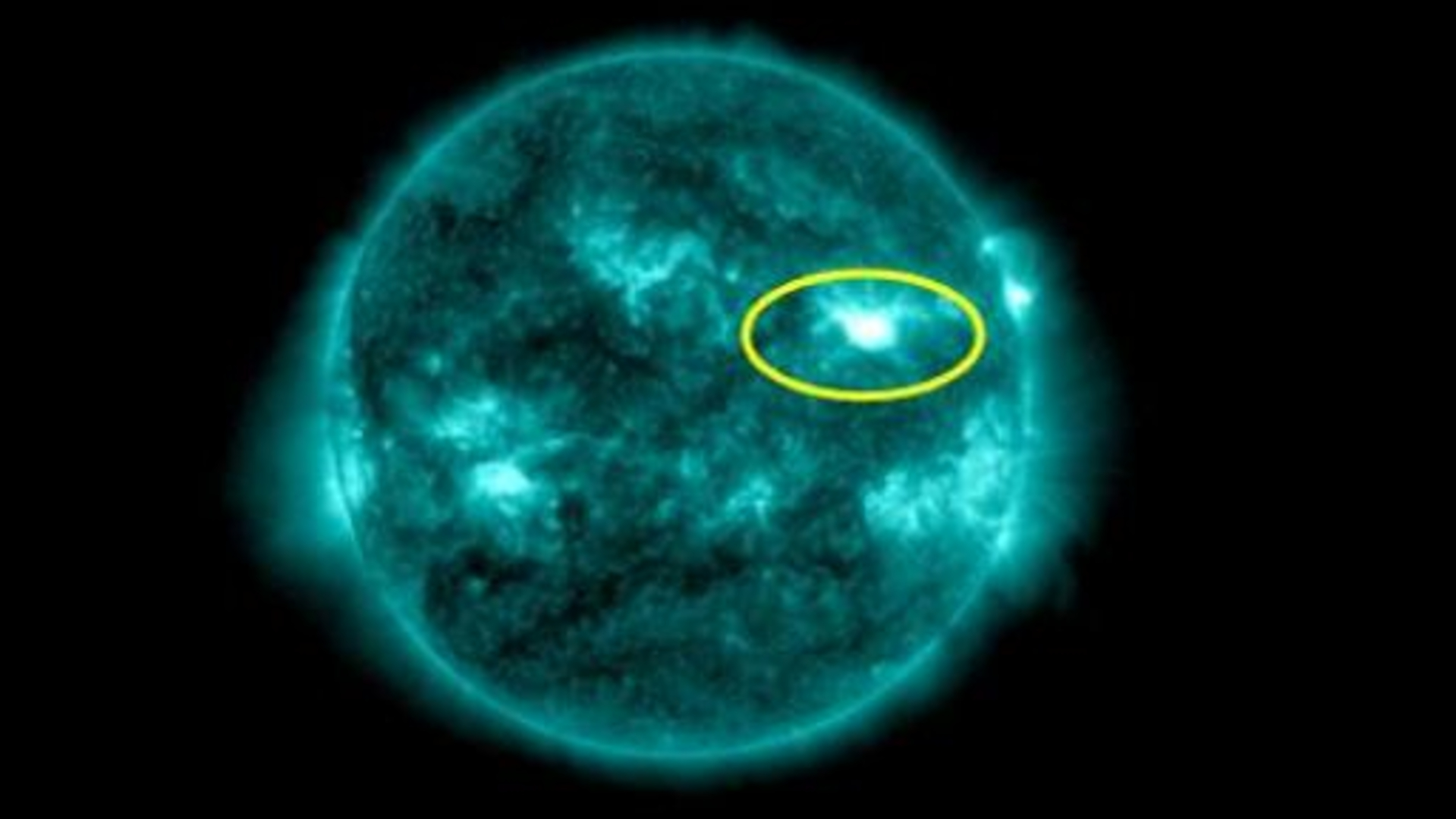
A coronal mass ejection spawned by the massive X1.1 solar flare on Dec. 29 has reached Earth and is expected to amp up the northern light overnight on Dec. 31 and Jan. 1, with space weather experts maintaining a G3 geomagnetic storm watch through the New Year.
"The anticipated CME that launched from the Sun on 29 Dec has arrived! SWPC forecast timing was very good as the shock arrival at the leading edge of the coronal mass ejection (CME) arrived at our solar wind observatory - NOAA DSCOVR and NASA ACE by 10:56am EST and reached Earth shortly afterwards," the Space Weather Prediction Center wrote in an update today. "As CME progression continues, the main magnetic “cloud” embedded within the CME should arrive and we anticipate G1-G3 potential to continue into the evening and early night hours across the U.S.."
Wednesday, Jan. 1: Northern lights ring in 2025 with stunning light shows
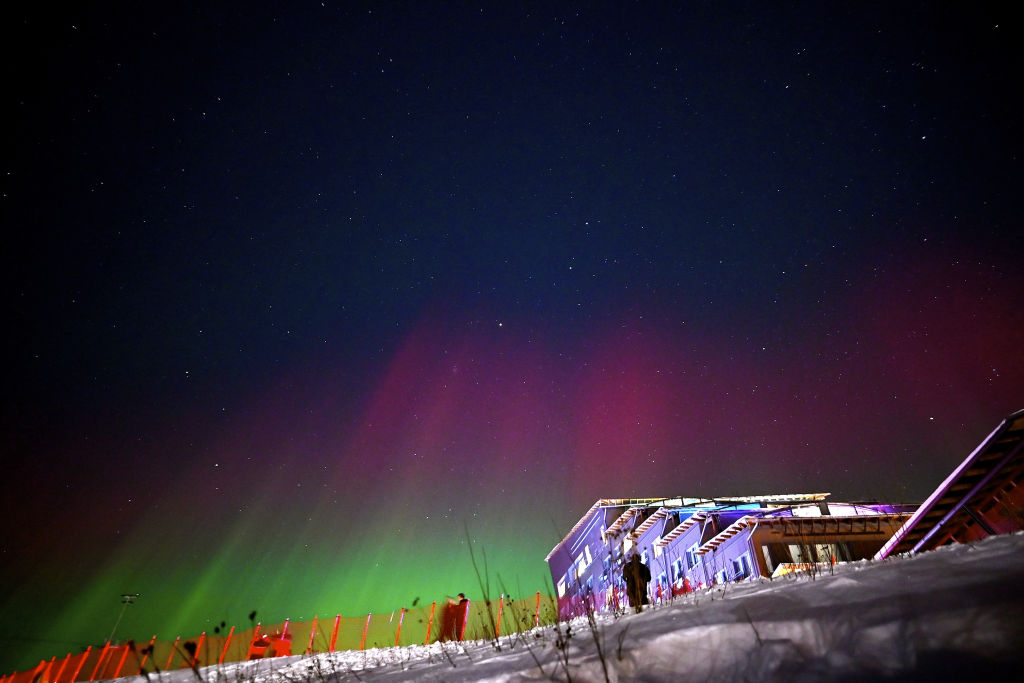
While many celebrated New Year's Eve with bursts of glittering fireworks, Earth joined the festivities with a natural display of its own: the northern lights.
A coronal mass ejection (CME) struck Earth's magnetic field on Dec. 31 at 11:21 a.m. EST (16:21 GMT), sparking minor geomagnetic storm conditions and painting the night sky with vivid aurora displays as far south as California, U.S, Austria, and Germany.
And it's not over yet! The sun started 2025 with a bang, hurling a new CME toward Earth, which could trigger more northern lights around Jan. 3 and Jan. 4, according to space weather physicist Tamitha Skov. "Our Sun rings in the New Year! We just had a new #solarstorm launch from Region 3939 in the Earth-Strike Zone," Skov wrote in a post on X.
Thursday, Jan. 2: High-latitude northern lights likely and mid-latitude auroras possible tonight
2025 is off to a great start in terms of northern lights and more shows could be on the horizon!
Several solar storms hit Earth over New Year's. For more than 9 hours, Earth's magnetosphere was rattled by powerful (G3 and G4) geomagnetic storms, producing widespread auroras deep into mid-latitudes.
As the current geomagnetic storm conditions begin to wane, aurora enthusiasts in high-latitude regions, such as northern Canada and Alaska, still have a strong chance of witnessing stunning auroral displays tonight. According to NOAA's Space Weather Prediction Center, the Kp index is forecasted to peak at 4 overnight.
Solar activity remains high, with several Earth-facing sunspot regions posing a potential risk of releasing solar storms, also known as coronal mass ejections (CMEs) in the coming days. Stay tuned for updates.
Colossal Earth-facing coronal hole detected
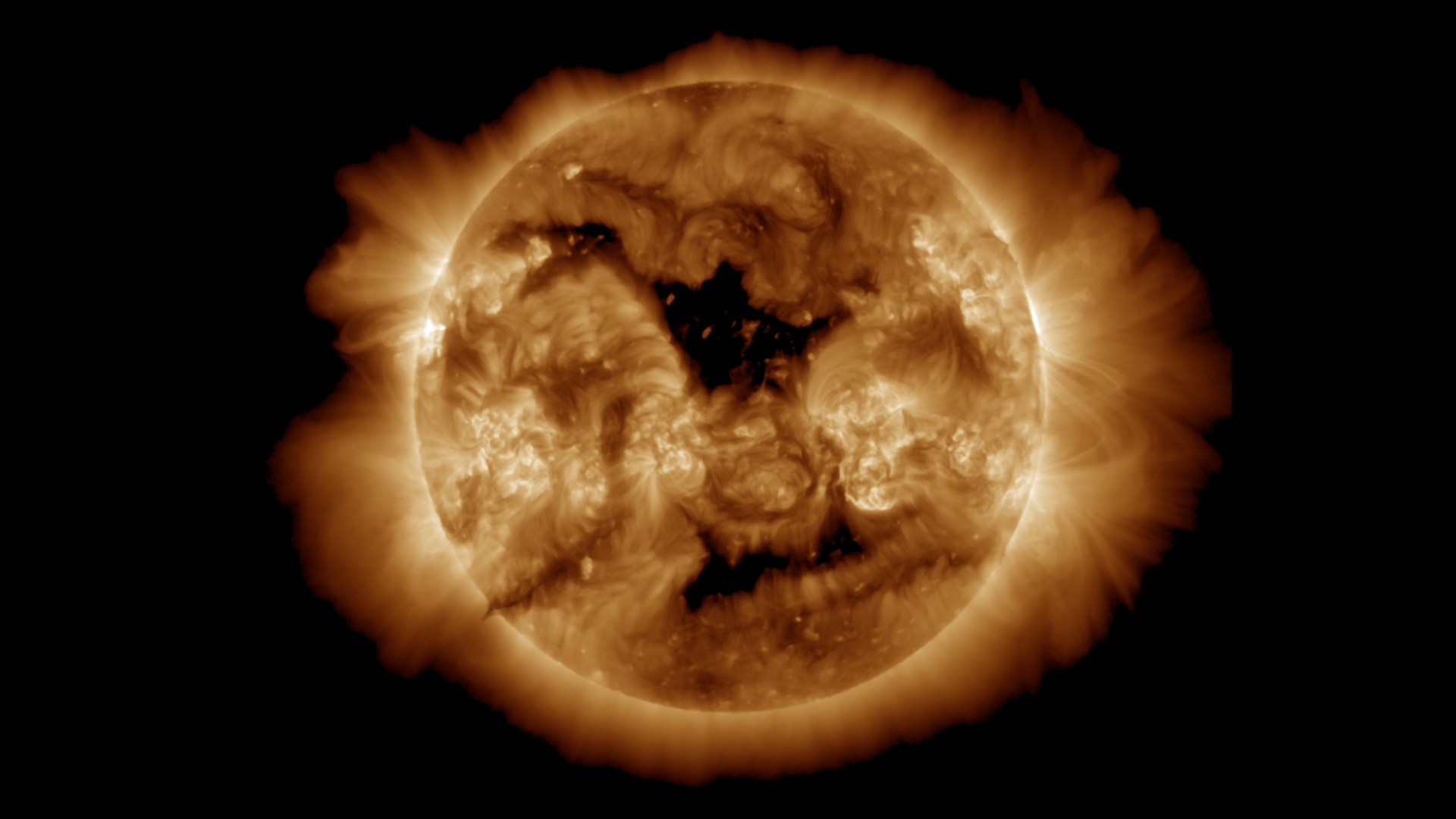
A large coronal hole has been detected on the sun and Earth is in the firing line.
This is good news for aurora chasers as coronal holes release high-speed solar wind streams. When these particles interact with Earth's magnetic field they increase geomagnetic activity which in turn can spark intense auroras.
Enhanced solar wind could arrive within about 3 days according to SpaceWeatherLive.
Aurora forecast for tonight and the weekend: Minor geomagnetic storm conditions predicted
Aurora chasers could be in for yet another treat this weekend as NOAA has issued another geomagnetic storm watch, this time for minor G1 conditions from Jan. 4 to Jan. 5. Northern lights are expected at high latitudes.
According to NOAA's Space Weather Prediction Center, the Kp index is forecasted to reach highs of 4.67 over the weekend.
The elevated conditions are due to two coronal holes spewing high-speed solar wind toward Earth. When directed at Earth these solar wind streams can interact with our planet's magnetic field and trigger geomagnetic storm conditions.
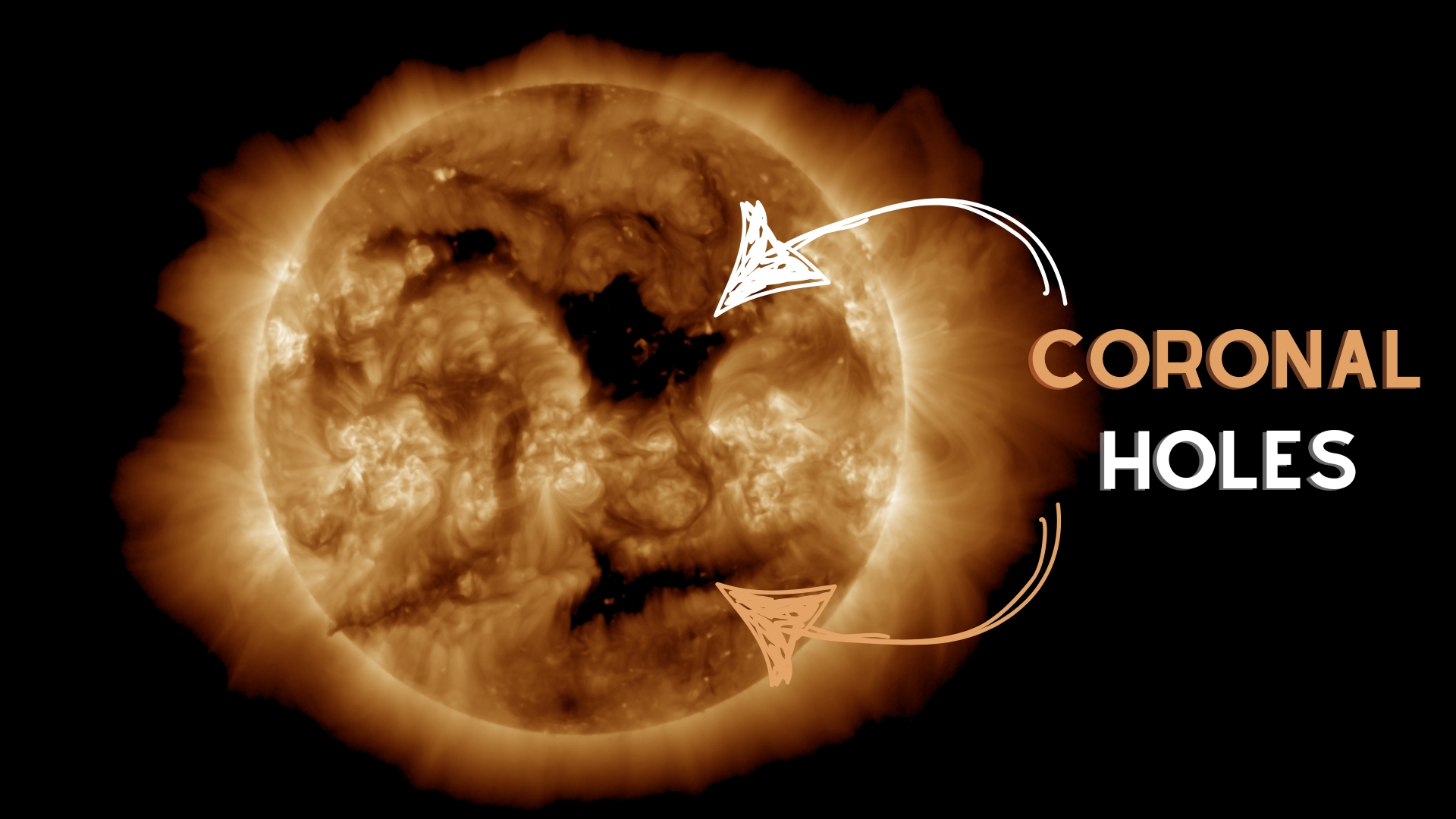
Northern Hemisphere aurora forecast courtesy of the Met Office
Monday, Jan. 6: Great chance of auroras for observers at high latitudes
Geomagnetic activity remains unsettled which is great news for aurora chasers at high latitudes.
According to NOAA's Space Weather Prediction Center, the Kp index is forecasted to reach highs of 4 over the next 24 hours.
These heightened conditions may result in visible auroras across the northern United States, while in the UK, they could be observed in the far north of Scotland.
According to the UK Met Office, Earth might experience a glancing blow from an incoming solar storm, or coronal mass ejection (CME), predicted to arrive late on January 6 or early January 7 (UTC). Should this occur, minor G1 geomagnetic storm conditions are possible.
Tuesday, Jan. 7: Unsettled conditions with strong chance of solar flares
The northern lights forecast looks promising for high-latitude observers tonight. According to NOAA's Space Weather Prediction Center, the Kp index is predicted to peak at 2.67 over the next 24 hours.
However, more unsettled space weather could be on the way. A large, active sunspot region is rotating into Earth's view and showing signs of intense activity. Just yesterday, sunspot group AR3947 unleashed a powerful M-class solar flare, accompanied by what appears to be an Earth-directed coronal mass ejection (CME).
"Region 3947 launches what looks to be an Earth-directed #solarstorm during an M4.8-flare! It is too early to tell without seeing coronagraph images, but the dimming regions around the eruption look promising (see the dark regions developing in the animation below). Stay tuned." Space Weather Physicist Tamitha Skov wrote in a post on X.
Region 3947 launches what looks to be an Earth-directed #solarstorm during an M4.8-flare! It is too early to tell without seeing coronagraph images, but the dimming regions around the eruption look promising (see the dark regions developing in the animation below). Stay tuned! pic.twitter.com/X6pAHfzdPqJanuary 6, 2025
When CMEs, also known as solar storms, hit Earth's magnetic field they can trigger geomagnetic storm conditions that can lead to dramatic aurora displays.
CMEs often accompany solar flares, but not always. Both are caused by magnetic disturbances in the sun's atmosphere, typically near active regions like sunspots. Solar flares are bursts of electromagnetic energy that travel at light speed, while CMEs are slower eruptions of plasma and magnetic fields that can take days to reach Earth. A flare may occur without a CME if no plasma is expelled, and CMEs can happen without a significant flare during gradual magnetic shifts.
According to SpaceWeatherLive's latest predictions, there's a strong chance we’ll see more powerful solar flares today. Here are the current probabilities:
M-class solar flare: 70%
X-class solar flare: 25%
Stay tuned for potential solar activity updates!
Wednesday, Jan. 8: Auroras mainly confined to high latitudes as geomagnetic activity wanes (for now)
Currently, solar activity is relatively low, with no Earth-directed solar storms. As such, tonight's northern lights will most likely be confined to latitudes above the Arctic Circle.
According to NOAA's Space Weather Prediction Center, the Kp index is predicted to peak at 2.33 over the next 24 hours.
We may experience a brief uptick in solar wind speed around Jan. 10 - Jan. 11, according to the UK Met Office. This is due to a small coronal hole in the sun, allowing solar wind to escape more readily into space.
Thursday, Jan. 9: Northern lights confined to high latitudes as geomagnetic activity remains relatively quiet
Relatively quiet geomagnetic activity will confine the northern lights primarily to high latitudes above the Arctic Circle tonight. According to NOAA's Space Weather Prediction Center, the Kp index is forecast to peak at 1.67 over the next 24 hours.
A brief uptick in solar wind speed is expected around Jan. 10–11, according to the UK Met Office. This is due to a small coronal hole in the sun, allowing solar wind to escape more readily into space. The elevated solar wind could trigger enhanced auroras at high latitudes.
The chance of powerful solar flares is decreasing as the once-active sunspot AR3947, which crackled with activity earlier this week, begins to decay. No significant sunspot regions have yet emerged over the sun's eastern limb (the left side as seen in imagery from the Solar Dynamics Observatory image below).
We’ll continue to monitor for any significant solar events that could lead to stronger northern lights displays. Stay tuned!
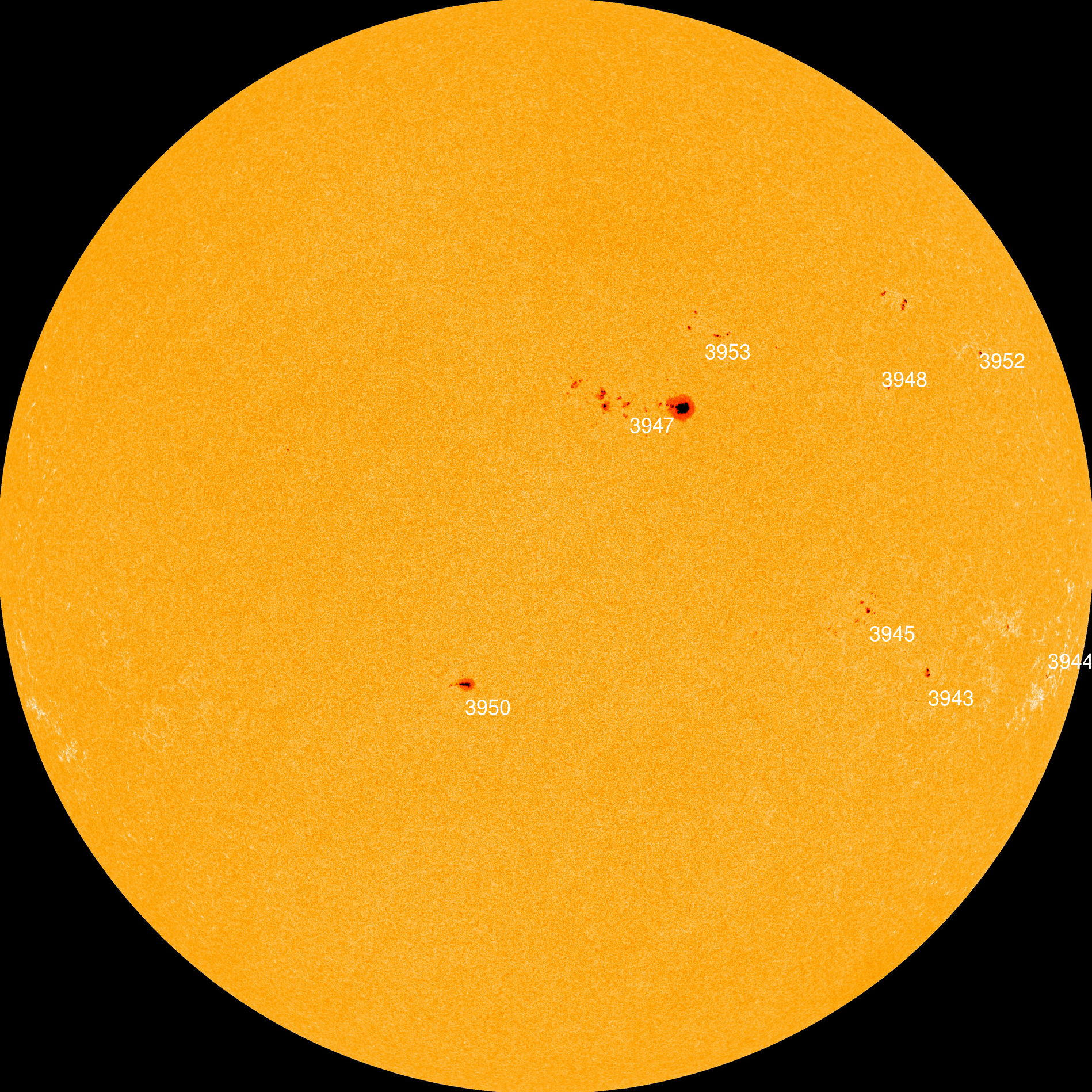
Aurora forecast for tonight and the weekend: Relatively quiet with possible unsettled conditions
Over the weekend relatively quiet geomagnetic activity will confine the northern lights primarily to high latitudes above the Arctic Circle. According to NOAA's Space Weather Prediction Center, the Kp index is forecast to peak at 3.33 over the weekend.
According to the UK Met Office, aurora activity may slightly increase on Jan.10 due to the influence of a high-speed solar wind stream emanating from a small coronal hole. A possible filament eruption from the sun might enhance geomagnetic conditions on Jan. 12.
Although things are currently looking rather quiet on the sun, two emerging sunspot regions over the sun's eastern limb might mix things up a bit should they grow rapidly in the coming days.
Thursday Jan. 16: Good chance of auroras at high latitudes with possible elevated conditions in the coming days
There is a good chance of seeing the northern lights at high latitudes tonight. According to NOAA's Space Weather Prediction Center, the Kp index is predicted to peak at 2.33 over the next 24 hours.
Aurora hunting conditions could improve in the coming days due to a giant Earth-facing coronal hole. This is great news for aurora chasers as coronal holes release high-speed solar wind streams. When these particles interact with Earth's magnetic field, they increase geomagnetic activity, which can spark intense auroras.
Enhanced solar wind could arrive within about 3 days according to SpaceWeatherLive.
A southern hemisphere coronal hole is facing Earth. Enhanced solar wind could arrive in ~3 days - Follow live on https://t.co/bsXLidnzGh pic.twitter.com/LnMFhUUSM4January 16, 2025
Aurora forecast for tonight and the weekend: Unsettled conditions possible
The northern lights will be confined primarily to high latitudes this weekend due to relatively quiet geomagnetic activity but an Earth-facing coronal hole could elevate conditions.
According to NOAA's Space Weather Prediction Center, the Kp index is forecast to peak at 3.67 over the weekend.
Although there are currently no incoming solar storms, the ongoing coronal hole influence is expected to enhance solar winds over the weekend which could lead to unsettled geomagnetic activity with isolated active intervals according to the UK Met Office. Aurora chasers keep your eyes peeled as we could experience minor geomagnetic storm conditions around Jan. 17 and Jan. 18 according to the UK Met Office.
Northern Hemisphere aurora forecast courtesy of the Met Office
Monday, Jan. 20: Good chance of northern lights at high latitudes tonight
There is a good chance of seeing the northern lights at high latitudes tonight. According to NOAA's Space Weather Prediction Center, the Kp index is forecast to peak at 2.67 over the next 24 hours.
Geomagnetic conditions have been unsettled over the last few days due to elevated solar winds from an Earth-facing coronal hole. These conditions will ease from Jan. 21 onward as the coronal hole rotates away from Earth.
Tuesday, Jan. 21: Waning geomagnetic activity confines auroras to high latitudes
Mainly quiet to unsettled geomagnetic activity confines the northern lights primarily to northern latitudes tonight.
According to NOAA's Space Weather Prediction Center, the Kp index is forecast to peak at 2.67 over the next 24 hours.
Geomagnetic conditions have been unsettled over the last few days due to elevated solar winds from an Earth-facing coronal hole. These conditions will ease from today as the coronal hole rotates away from Earth.
Potential solar storm eruption may trigger geomagnetic storm activity in the coming days
The sun erupted with an M-class solar flare, the second most powerful class of solar flare today. The flare peaked at 5:39 a.m. ET (1039 GMT) and was accompanied by a coronal mass ejection (CME), also known as a solar storm.
CMEs are vast plumes of plasma and magnetic field from the sun. If they strike Earth and the conditions are right, they can trigger geomagnetic storms, which in turn lead to spectacular aurora displays.
There’s a slight chance of minor G1-level geomagnetic storms through Jan. 24 according to the UK Met Office. However, forecasters are still waiting for an analysis to see if the incoming CME has any Earth-directed components. We'll keep you informed of any significant developments!
Spectacular CME from the M3.3 long duration flare in SUVI 304A EUV data! Still awaiting LASCO C2 imagery. https://t.co/JvkhPjdXwg pic.twitter.com/e2cyo5ZeYyJanuary 21, 2025
Wednesday, Jan. 22: Earth-directed solar storm could supercharge auroras by Jan. 24
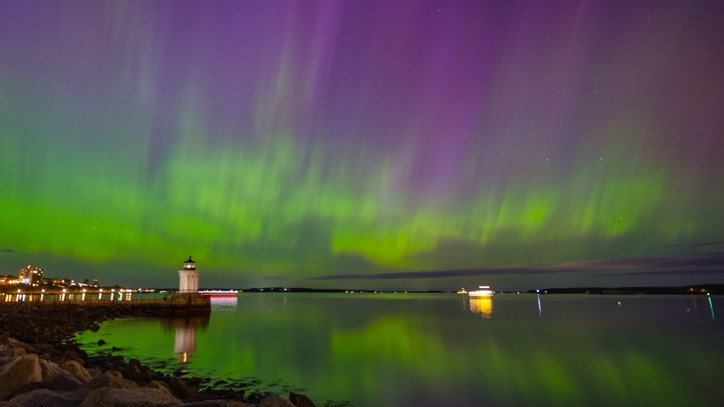
Aurora chasers, get ready — things are looking promising! An incoming solar storm could light up the skies with northern lights potentially visible as far south as northern Michigan and Maine on Jan. 24.
NOAA's Space Weather Prediction Center forecasts that the Kp index will peak at 2 over the next 24 hours, and rise to 4.33 by Jan. 24.
The sun unleashed the solar storm, or coronal mass ejection (CME), during an eruptive M-class solar flare on Jan. 21. According to NASA models, part of the CME is expected to graze Earth on Jan. 24, potentially sparking minor G1 geomagnetic storm conditions — ideal for aurora displays beyond the regular high latitude range.
Keep an eye on the skies and your aurora alerts!
The partially Earth-directed #solarstorm from 3967 today shows some gorgeous rotational dynamics, but it will serve to keep the bulk of the storm to the East of Earth. (See the second animation.) We should get a glancing blow mid to late January 24. #Aurora possible, especially… pic.twitter.com/Vkdqu1dQkbJanuary 22, 2025
Thursday, Jan. 23: Incoming solar storm could supercharge auroras this week
A solar storm, known as a coronal mass ejection (CME), erupted from the sun on Jan. 21 and is expected to deliver a glancing blow to Earth.
This event could trigger minor geomagnetic storm activity, potentially producing northern lights visible at higher latitudes, such as northern Michigan and Maine.
The NOAA Space Weather Prediction Center projects the Kp index to peak at 5.33 within the next 48 hours, with G1 geomagnetic storm conditions possible tomorrow night (Jan. 24) between 10:00 p.m. and 4:00 a.m. EDT (0300-0900 GMT on Jan. 25).
Northern Hemisphere aurora forecast courtesy of the Met Office
Friday, Jan. 24: Possible geomagnetic storm could spark auroras at mid-latitudes
All aboard the solar storm train! Two coronal mass ejections (CMEs) are on track to strike Earth with glancing blows on Jan. 24-25.
The first CME was released during an M-class solar flare eruption on Jan. 21 and the second from a filament eruption on Jan. 22.
If both CMEs land a blow their combined result could be minor (G1) to moderate (G2) geomagnetic storm conditions according to Spaceweather.com. Skywatchers could see northern lights as far south as New York and Idaho if G2 conditions are reached.
Monday, Jan. 27: Quiet geomagnetic activity confines northern lights to high latitudes
Geomagnetic activity is expected to remain quiet over the next few days, with northern lights primarily visible at high latitudes, especially above the Arctic Circle.
The NOAA Space Weather Prediction Center projects the Kp index to peak at 1.67 within the next 24 hours.
Things could be looking up on Jan. 29 as a new coronal mass ejection (CME) could land Earth with a glancing blow and trigger minor (G1) class geomagnetic storm conditions, according to Spaceweathercom.
Tuesday, Jan. 28: Incoming coronal mass ejection may ignite stunning auroras tonight
Enhanced geomagnetic activity is expected tonight, with northern lights likely visible at high latitudes, particularly above the Arctic Circle. Earth is anticipated to experience a glancing impact from a coronal mass ejection (CME) released on January 26, which could spark minor (G1) geomagnetic storm conditions, according to Spaceweather.com.
The NOAA Space Weather Prediction Center projects the Kp index to peak at 2.67 within the next 24 hours.
Wednesday, Jan. 29: Northern lights remain confined to high latitudes tonight but unsettled conditions could spark more intense displays
Unsettled geomagnetic activity is expected tonight with a slight chance of minor G1 geomagnetic storm conditions should any incoming coronal mass ejections (CMEs) land Earth with a glancing blow.
The northern lights remain confined to high latitudes but could reach mid-latitudes if geomagnetic storm conditions intensify.
The NOAA Space Weather Prediction Center projects the Kp index to peak at 2.67 within the next 24 hours.
Thursday, Jan. 30: Auroa conditions are quiet tonight but may pick up in the coming days

While geomagnetic conditions remain quiet for now, keeping the northern lights confined to high latitudes, activity could intensify in the coming days.
A giant coronal hole is currently aiming aurora-sparking solar wind directly at Earth. The incoming solar wind is expected to arrive around Jan. 31 to Feb. 1. In doing so it could potentially spark minor (G1) geomagnetic storm conditions which could see auroras reach as far south as northern Michigan and Maine.
The NOAA Space Weather Prediction Center projects the Kp index to peak at 2.67 within the next 24 hours. Aurora chasers make sure those cameras are charged! We could be seeing Kp's of 4.33 by Feb. 1!
Aurora forecast for tonight and the weekend: Minor geomagnetic storm could supercharge northern lights this weekend
Heads up aurora chasers!
The NOAA Space Weather Prediction Center projects the Kp index to peak at 4.67 over the weekend. For an up-to-date breakdown of timings check out NOAA's 3-day forecast.
A giant coronal hole is currently aiming aurora-sparking solar wind directly at Earth. The incoming solar wind is expected to arrive around Jan. 31 to Feb. 1. In doing so it could potentially spark minor (G1) geomagnetic storm conditions which could see auroras reach as far south as northern Michigan and Maine.
Keep your cameras charged and your eyes on the skies!







